AP Bio Unit 4, AP Bio Unit 6, AP Bio Unit 7
1/84
There's no tags or description
Looks like no tags are added yet.
Name | Mastery | Learn | Test | Matching | Spaced |
|---|
No study sessions yet.
85 Terms
How do cells communicate?
by generating, transmitting, receiving, and responding to chemical signals
How does a cell communicate with another cell that it's touching
1. Juxtracrine signaling
2. In animals, this is done by gap junction (little holes connecting membranes)
3. In plants, this is done by plasmodesmata (little holes connecting cell wall)
4. this can also be done via proteins
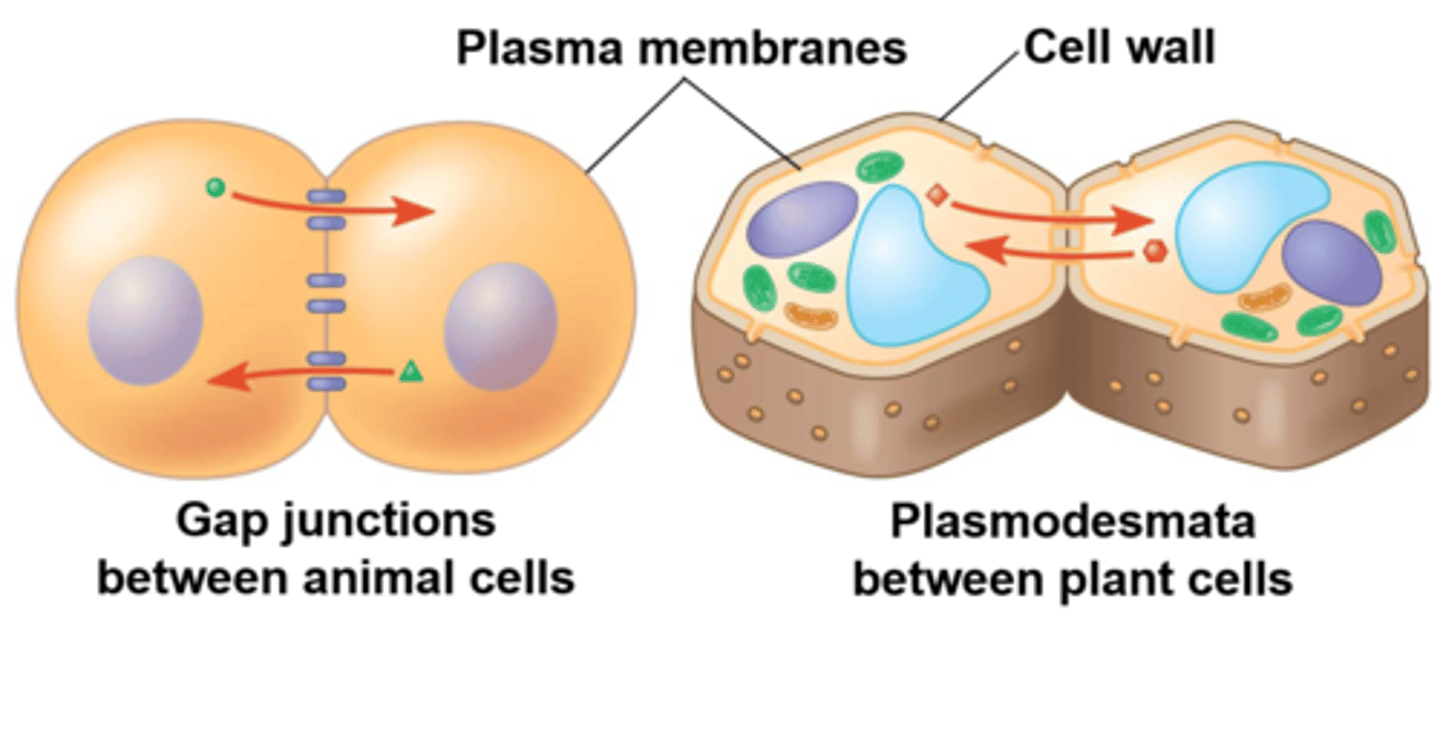
How do cells a short distance away communicate? (close but not touching)
Paracrine signaling: cell secretes a signaling molecule that will signal close by cells that have a receptor for it.
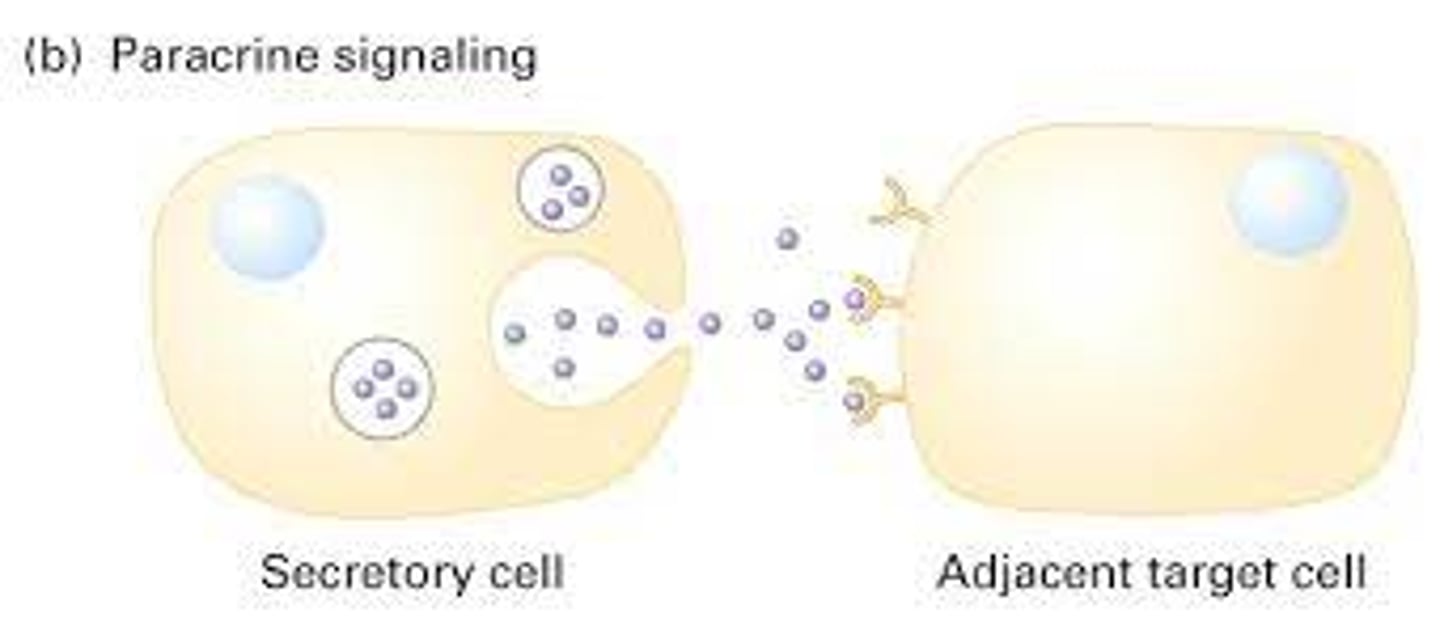
How do cells communicate with cells that are far away?
Endocrine signaling: cells secrete a signaling molecule, usually into the bloodstream, that will travel to a far away cell. The molecules are usually hormones traveling through the blood stream.
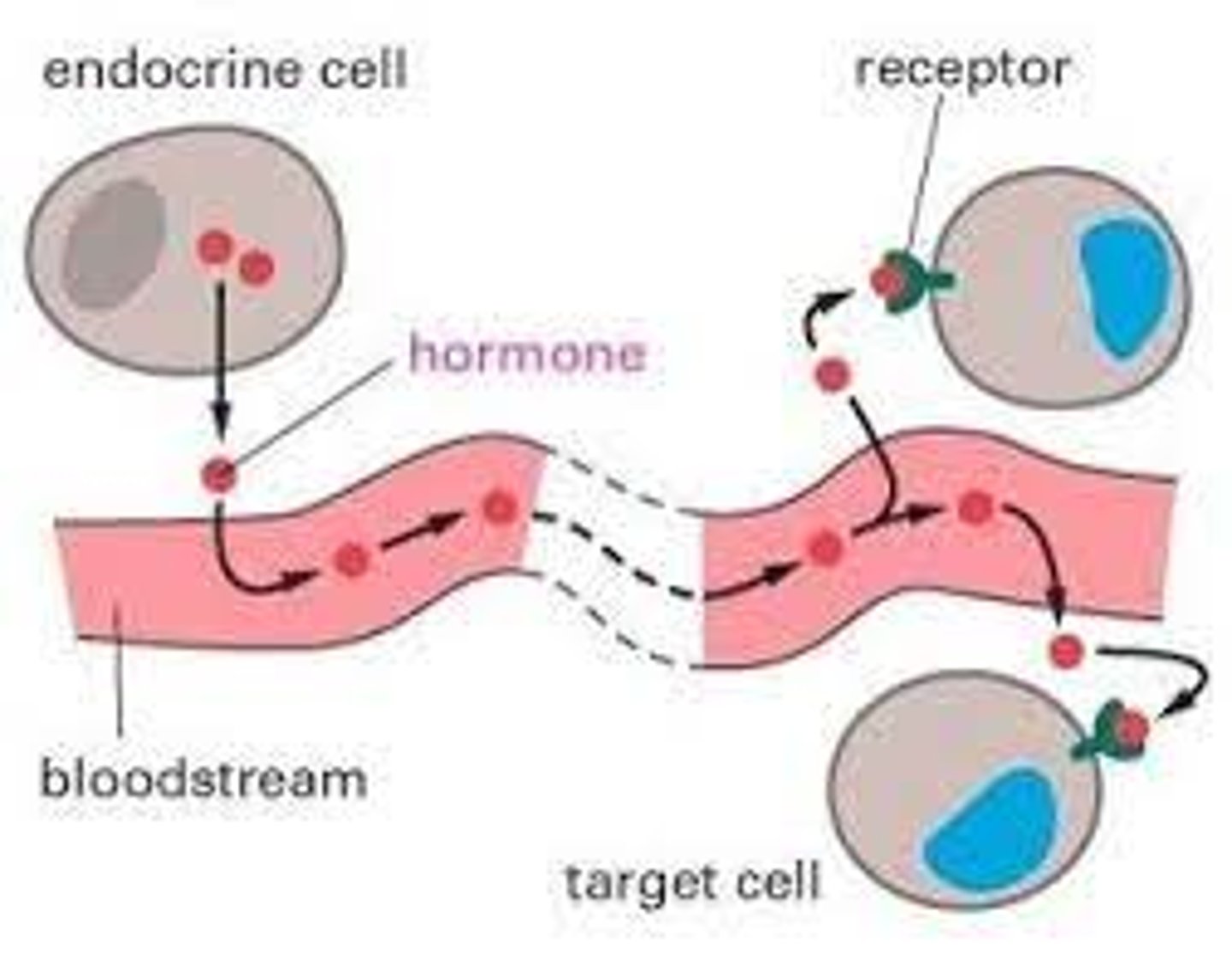
How does a cell signal itself?
Autocrine: a cell secretes a signaling molecule that binds to its own receptors.

what are signaling molecules called? what do they do?
Ligands: bind to a receptor protein in or on another cell to make it do something
What are the three stages of cell signaling?
1. Reception: the signal is received
2. Transduction: a series of reactions happen in the signal transduction pathway, which amplifies the signal
3. Response: what the cell actually does
How can cell signaling be messed up?
mutations can cause cells to not be able to send or receive signals
For example, the SRY gene controls testosterone production, but mutations can mess this gene up and someone with an XY chromosome will develop into a female because they can't make the signaling molecule testosterone. This is called Swyer Syndrome.
What are the two types of feedback?
1. Negative feedback: Tries to maintain a constant level of something (homeostasis)
Ex: If blood glucose is too high, insulin will be made to decrease it, if blood glucose is to low, glucason will be made to increase it.
2. Positive feedback: tries to create more of the same response
Ex: childbirth.
The baby pushes in the cervix, stretching the uterus, which sends a signal to the brain to release oxytocin. Oxytocin causes the uterus to contract and the baby to push on the cervix more, creating a positive feedback loop.
What are the phases of the cell cycle?
1. Interphase: 90% of the cells life. Normal functions.
2. Gap 1 (G1): cell grows
3. Synthesis (S phase): DNA replicated
4. Gap 2 (G2): cell grows some more
5. Mitosis: cell duplicates
6. Cytokinesis: after mitosis, the cytoplasm is divided, separating the two cells made from mitosis.
What are the four phases of mitosis?
prophase, metaphase, anaphase, telophase (PMAT)
parts of a chromosome
chromosomes are counted by the amount of centromeres. A chromosome with two sister chromatids is still one chromosome, just with double DNA.
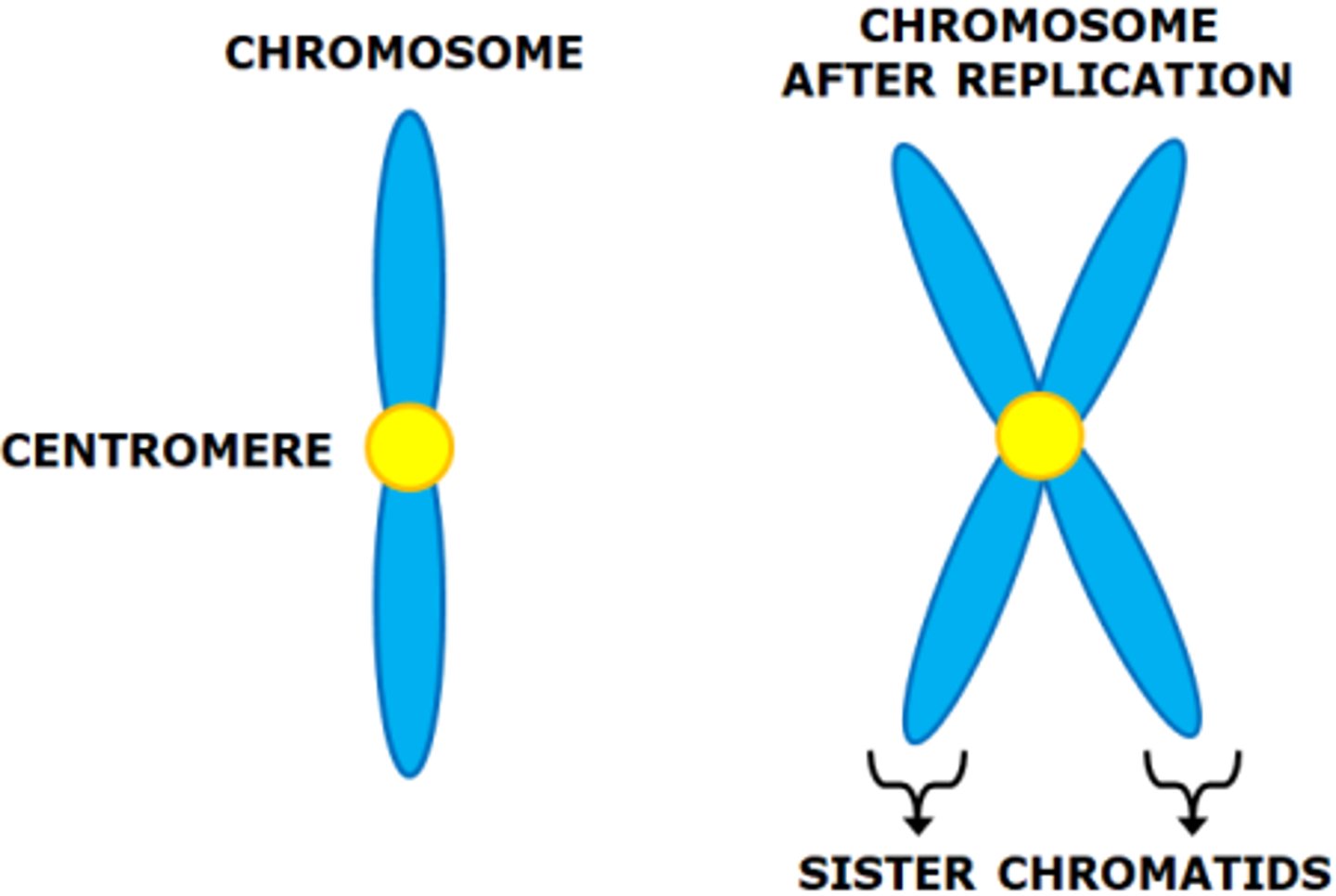
Describe prophase
1. spindle fibers form
2. nuclear envelope breaks down
3. chromatin (long strings of DNA) turns to chromosomes (nicely packed structures of DNA)
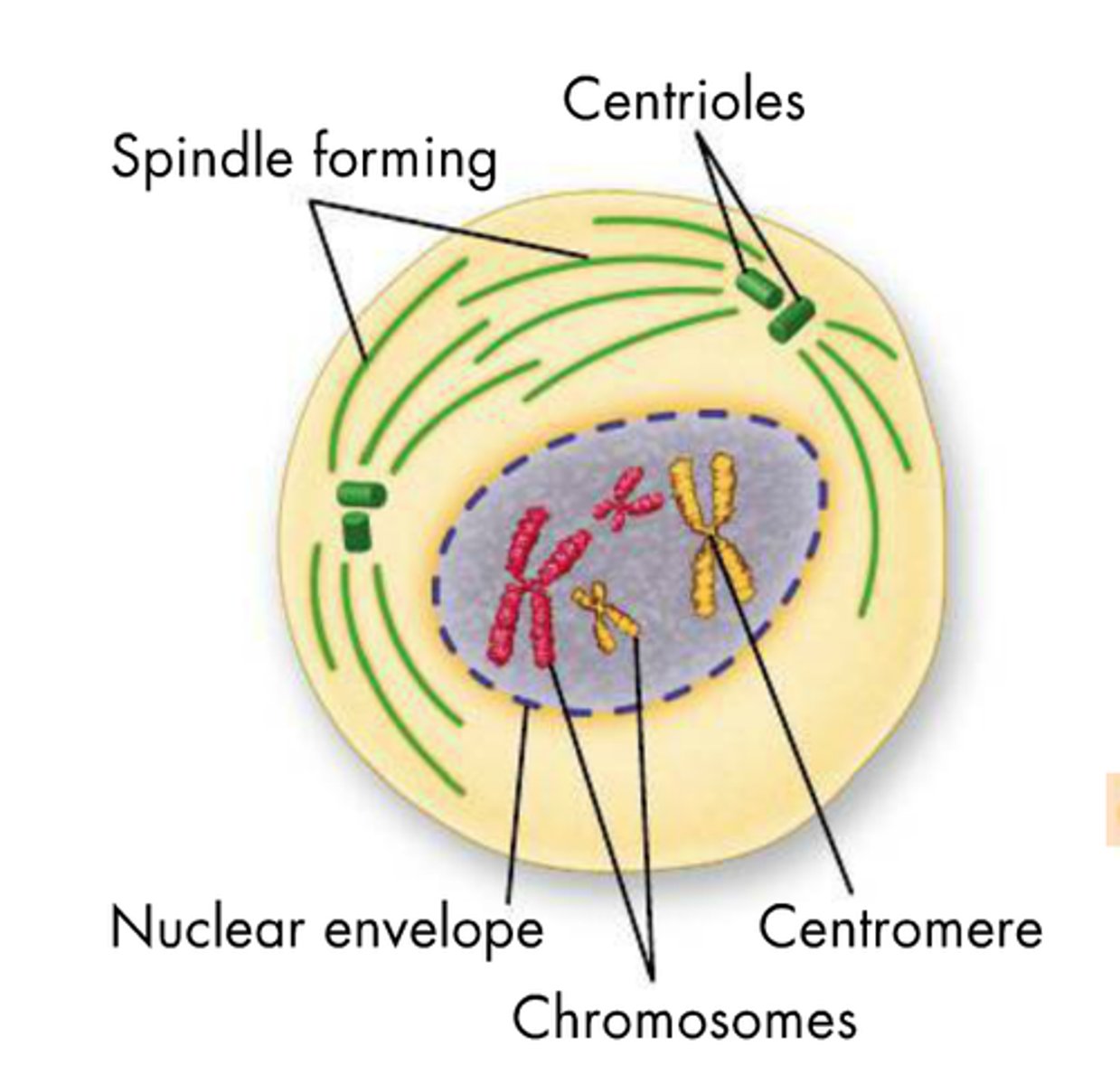
Describe metaphase
1. Chromosomes align in the center
2. centrioles go to the poles
3. spindle fibers attach to the chromosomes and centrioles

Describe anaphase
spindle fibers rip sister chromatids apart, doubling the amount of chromosomes.
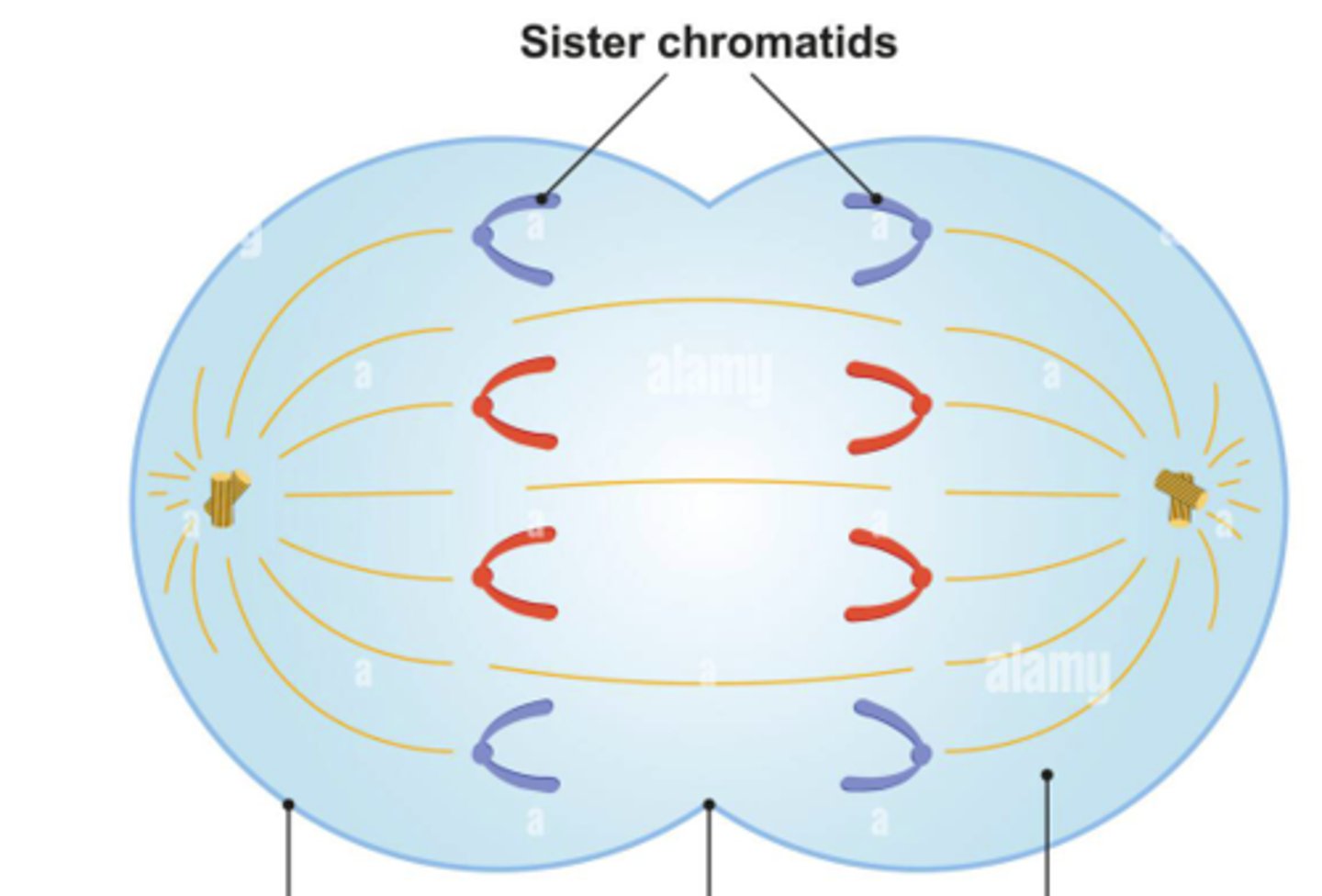
Describe telophase
1. Cleavage happens as the cell begins to split
2. Two nuclei begin to form, one for each new set of chromosomes

What is the final product of mitosis (after cytokinesis)
Two identical daughter cells
What regulates the cell cycle?
Cyclin dependent kinase (Cdks)
Cdks activate target enzymes based on what type of cyclin binds to their active site.
For example, if S-phase cyclin binds to Cdks, dna will be replicated
At what points in the cell cycle is each type of cyclin present?
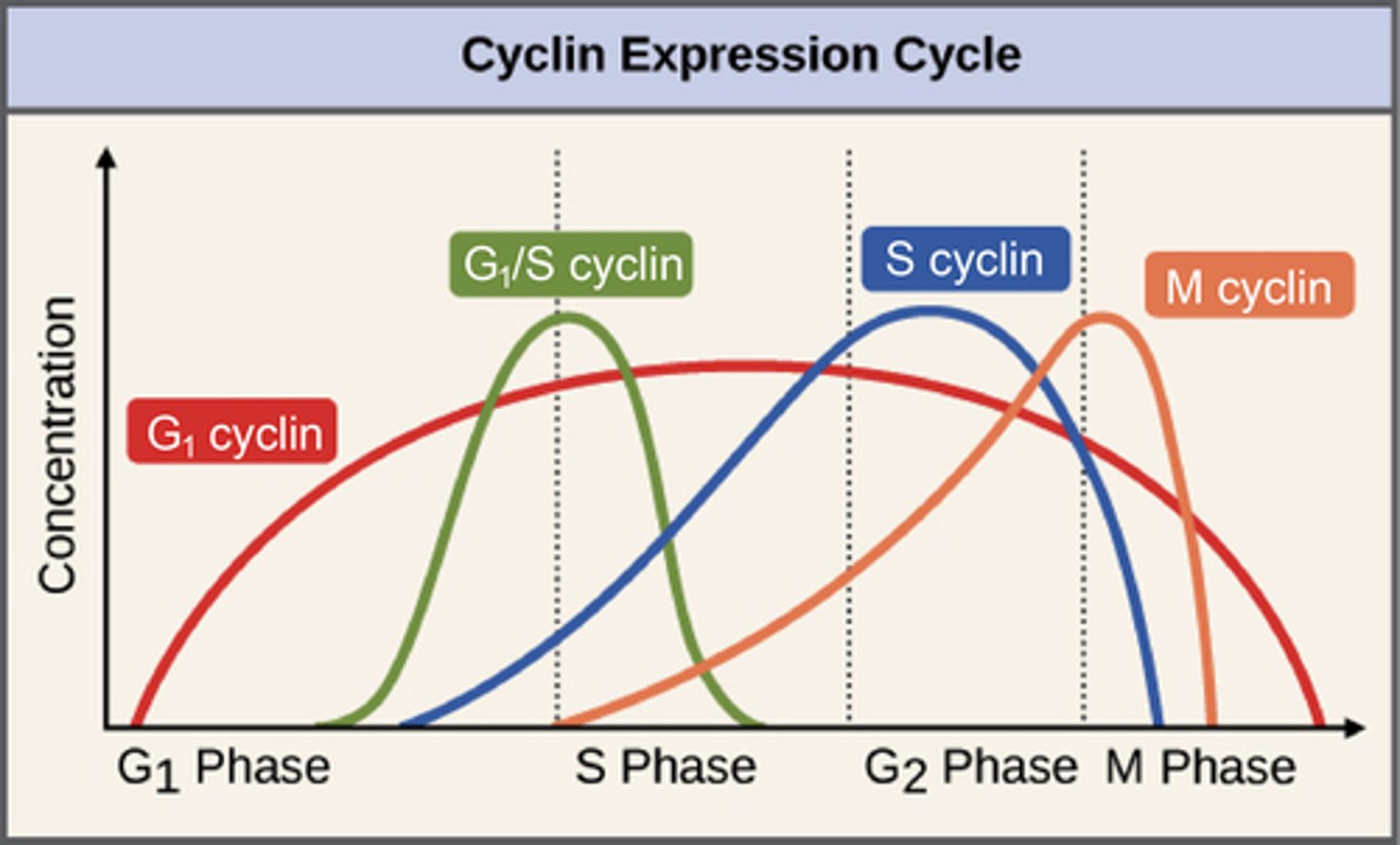
What does DNA and RNA stand for? what do they each look like? (one key difference in appearance)
1. Deoxyribonucleic acid: double stranded
2. Ribonucleic acid: single stranded
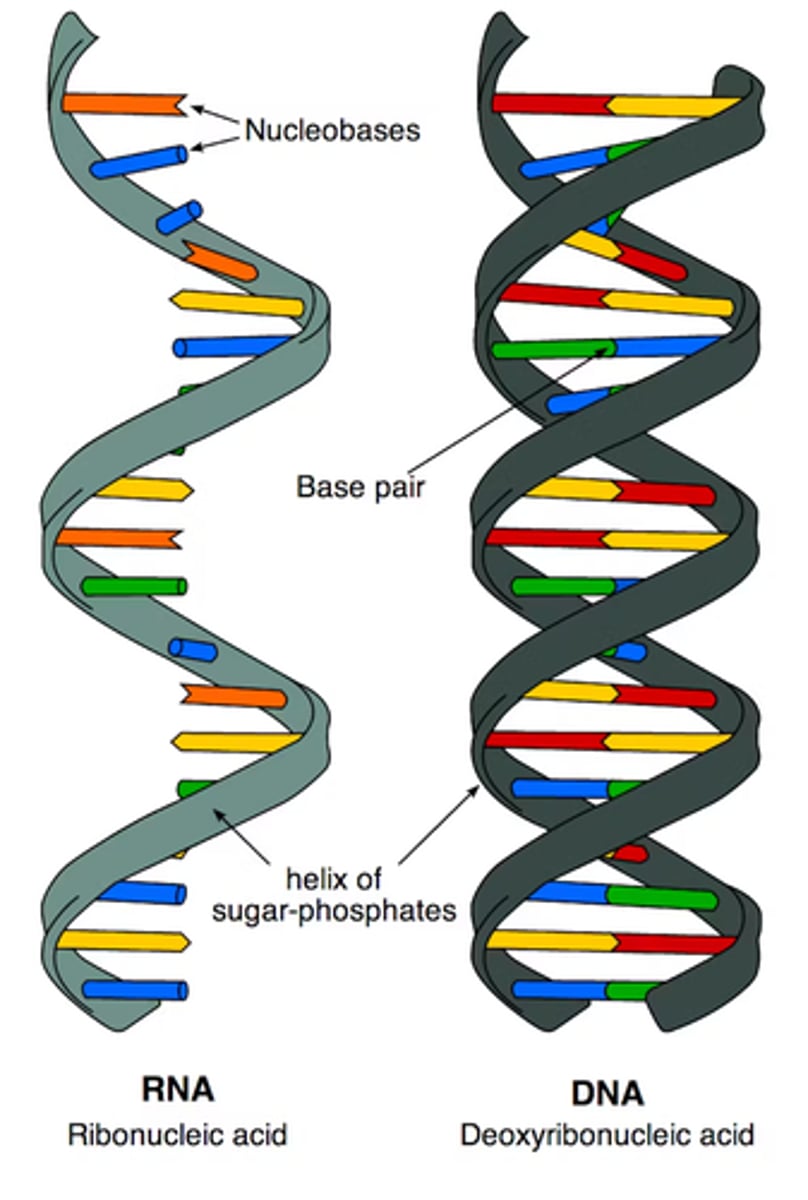
What are the DNA and RNA bases? which others do they pair with?
DNA:
Adenine -> thymine (two bonds)
Guanine -> cytosine (three bonds)
RNA:
Adenine -> Uracil (two bonds)
Guanine -> Cytosine (three bonds)
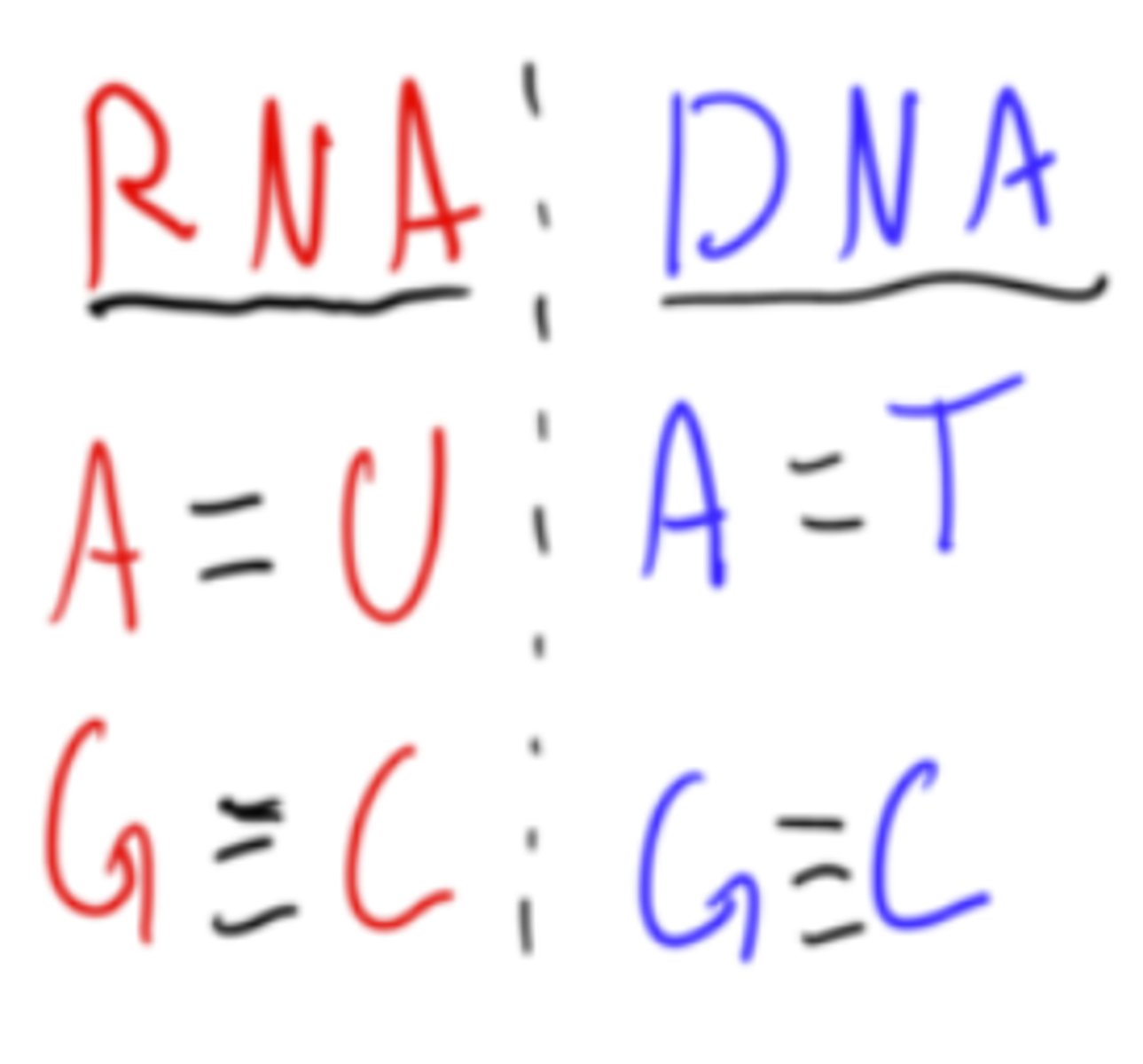
What are the three parts of a nucleotide (monomer of nucleic acid)?
1. Phosphate
2. Nitrogenous base
3. 5 carbon sugar
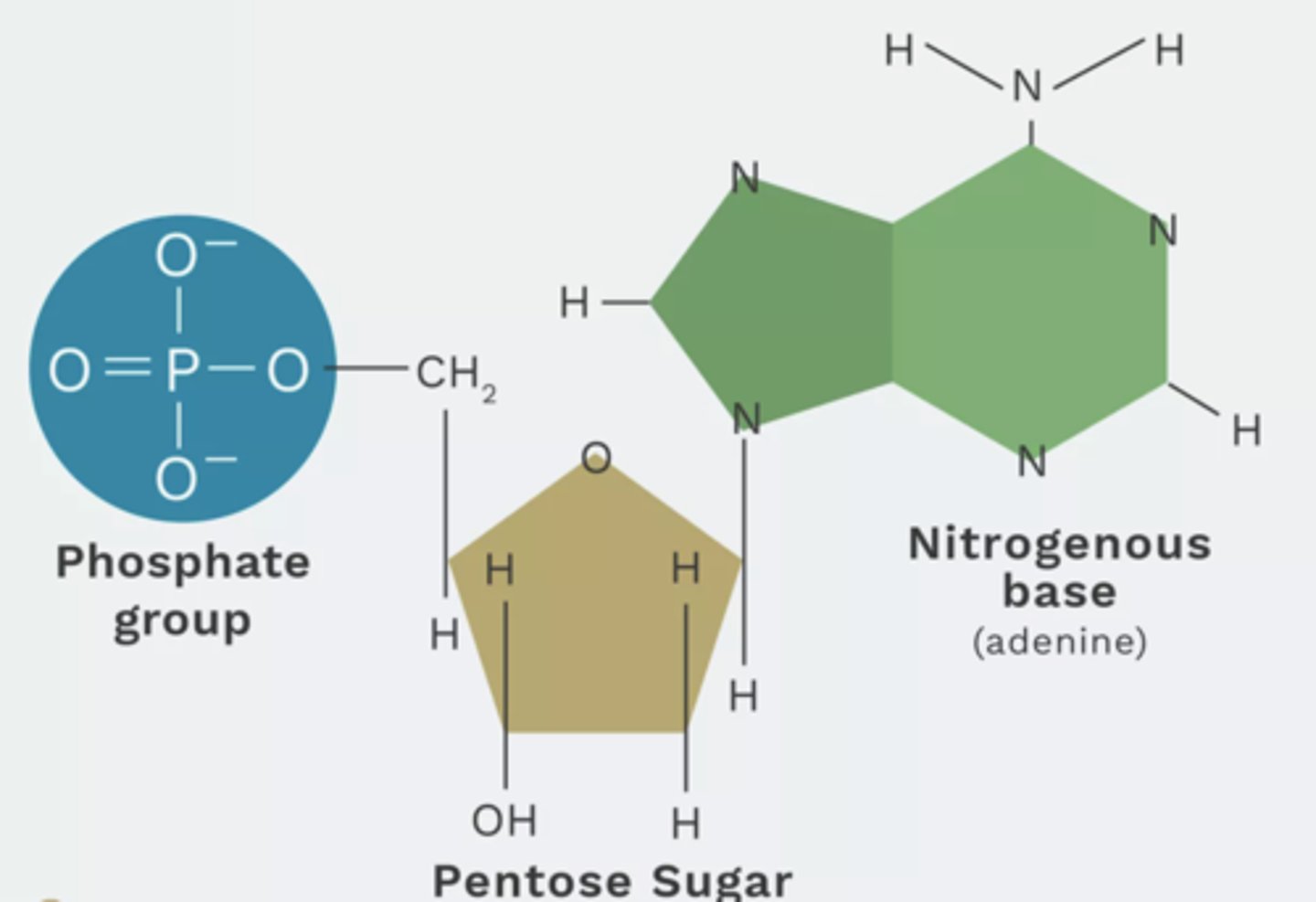
What are the two types of nucleotides?
1. Purines: Adenine and Guanine
2. Pyrimidines: Thymine, Cytosine, and Uracil
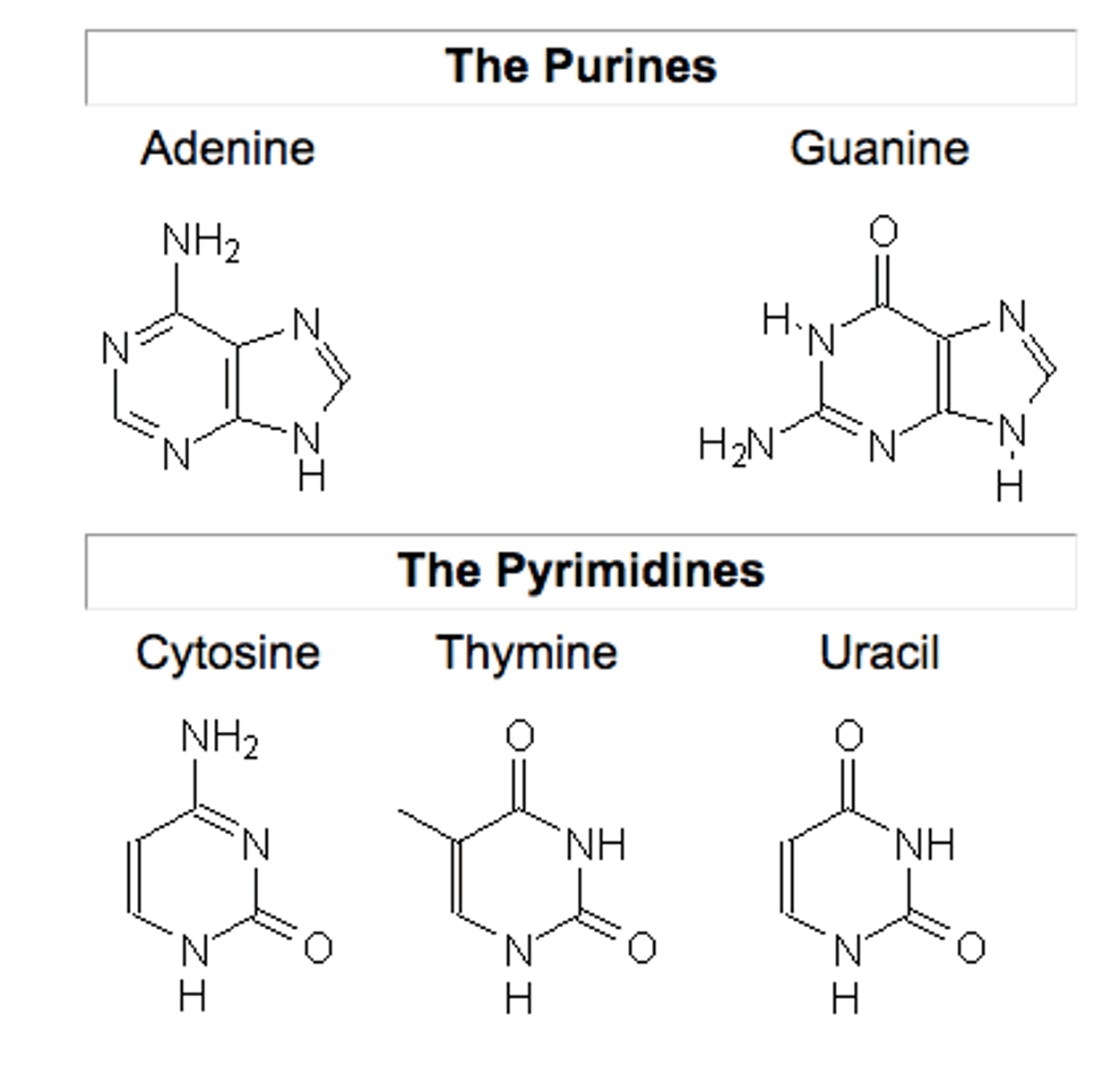
What is DNA like in prokaryotes vs. eukaryotes?
1. Prokaryotes: DNA is circular, one end connects to the other
2. Eukaryotes: DNA is linear

What happens during S phase of mitosis
DNA replication
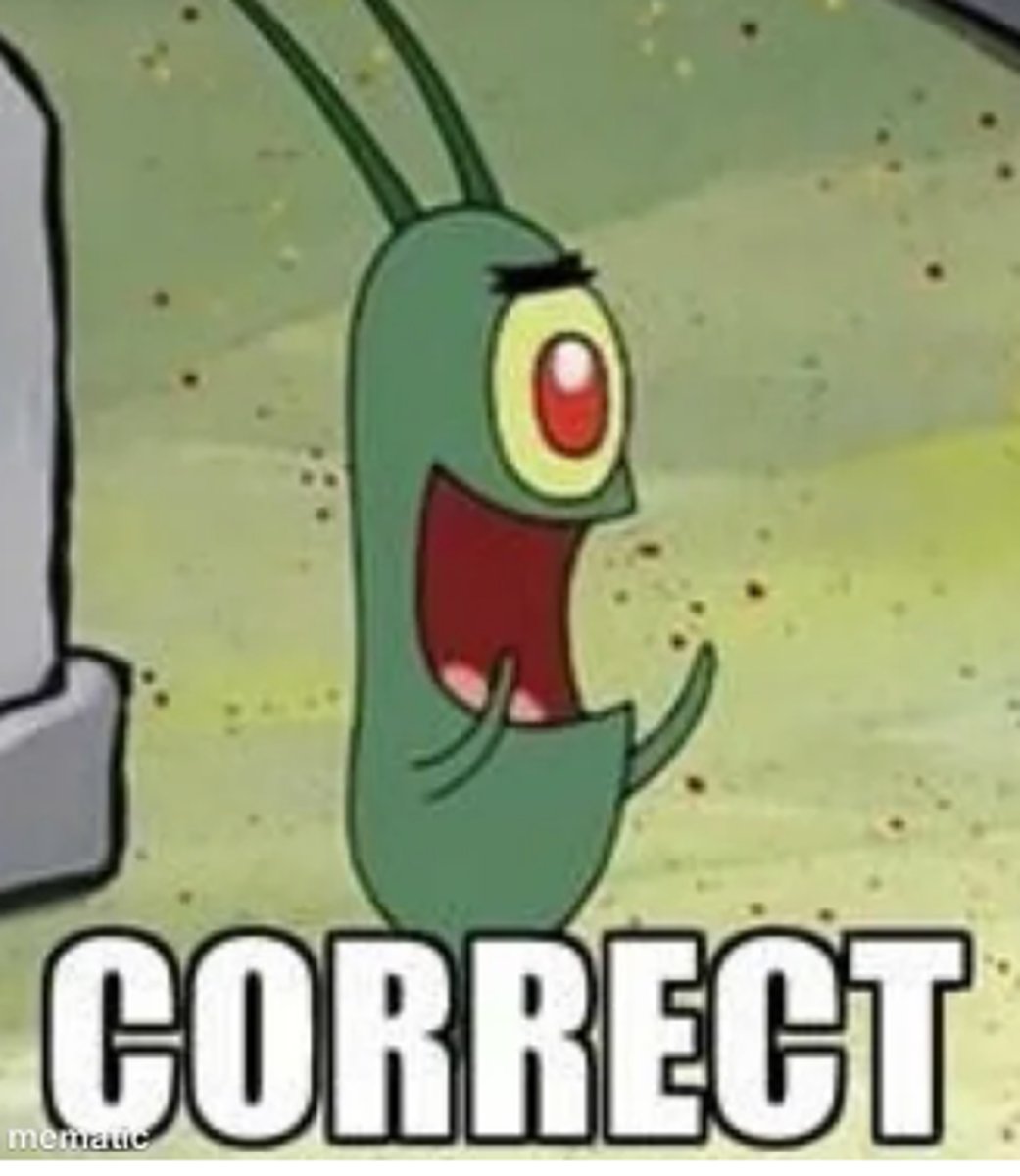
In what direction is DNA synthesized?
5' to 3' direction
one end of a DNA strand is 3' and one is 5'
each strand runs the opposite direction of the other (antiparallel)
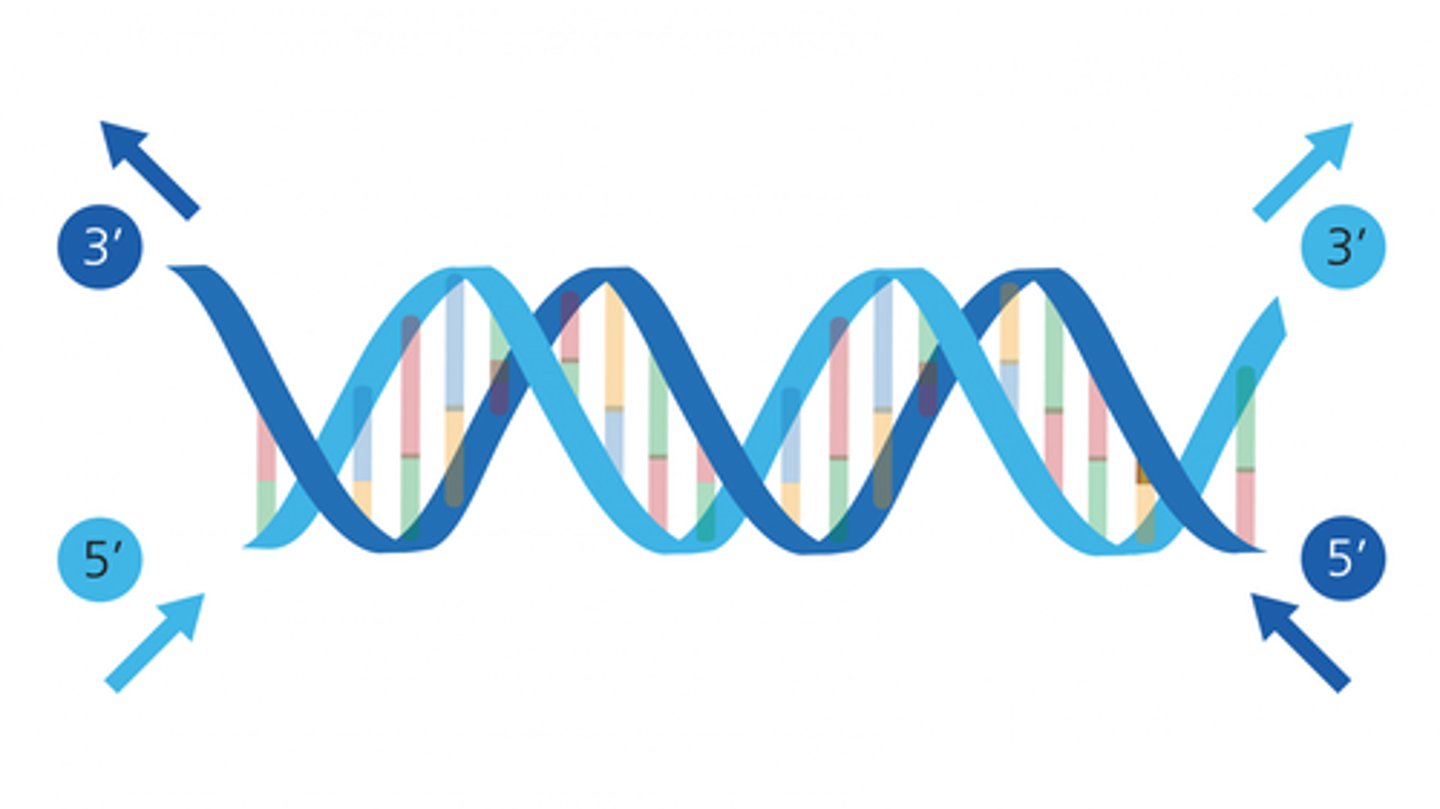
DNA replication video >>>
https://youtu.be/TNKWgcFPHqw?si=wskmE9vJi5bGEMS6
or search "DNA replication 3d"
What is the first step in DNA replication?
Helicase unwinds the DNA
Topoisomerase (not in image) relaxes the supercoiling that occurs from the DNA unwinding
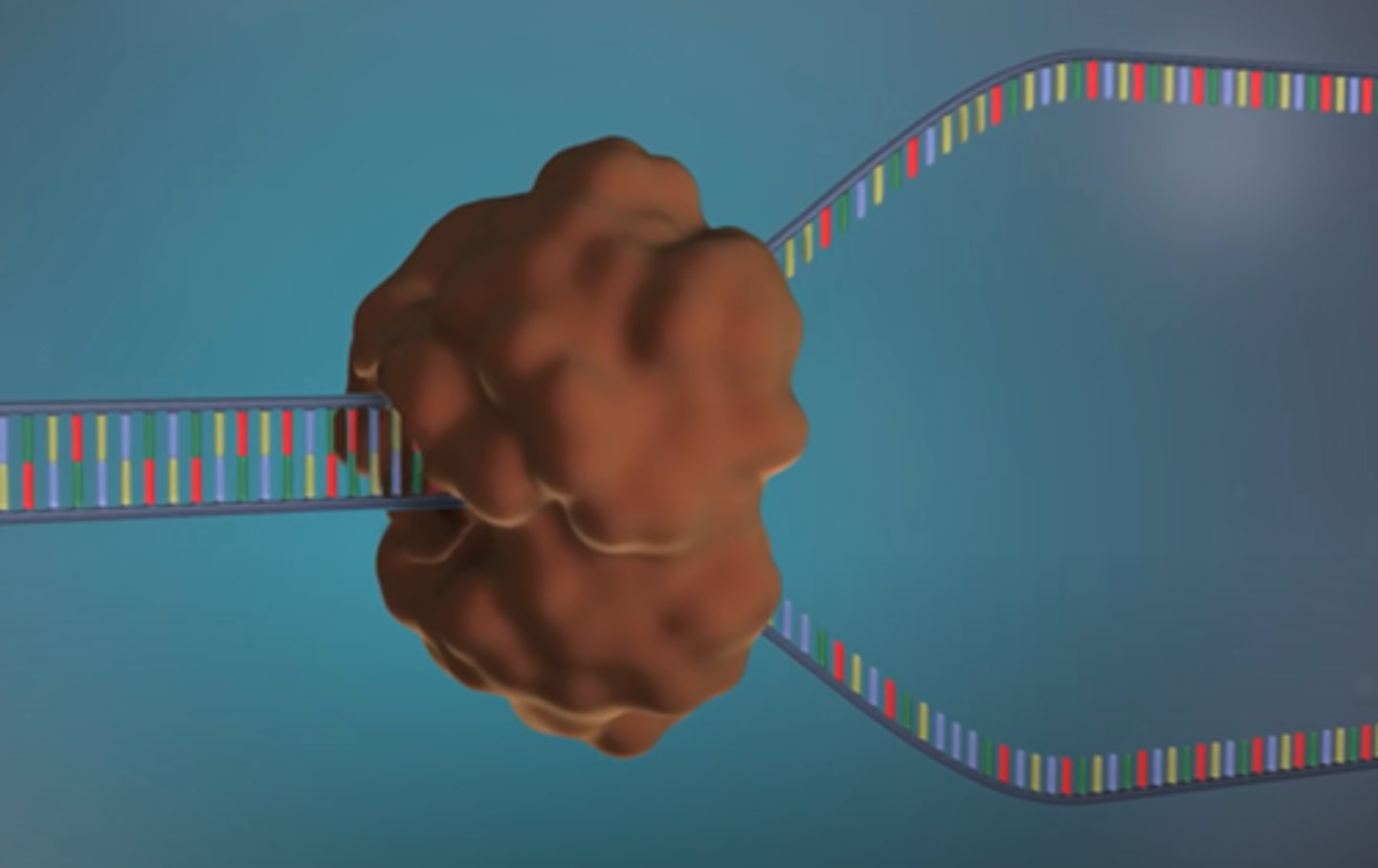
What is the second step in DNA replication
Primase makes a small piece of RNA called an RNA primer on the unwound strand of DNA
This is important for the next step to begin because it marks the starting point for the synthesis of the new strand
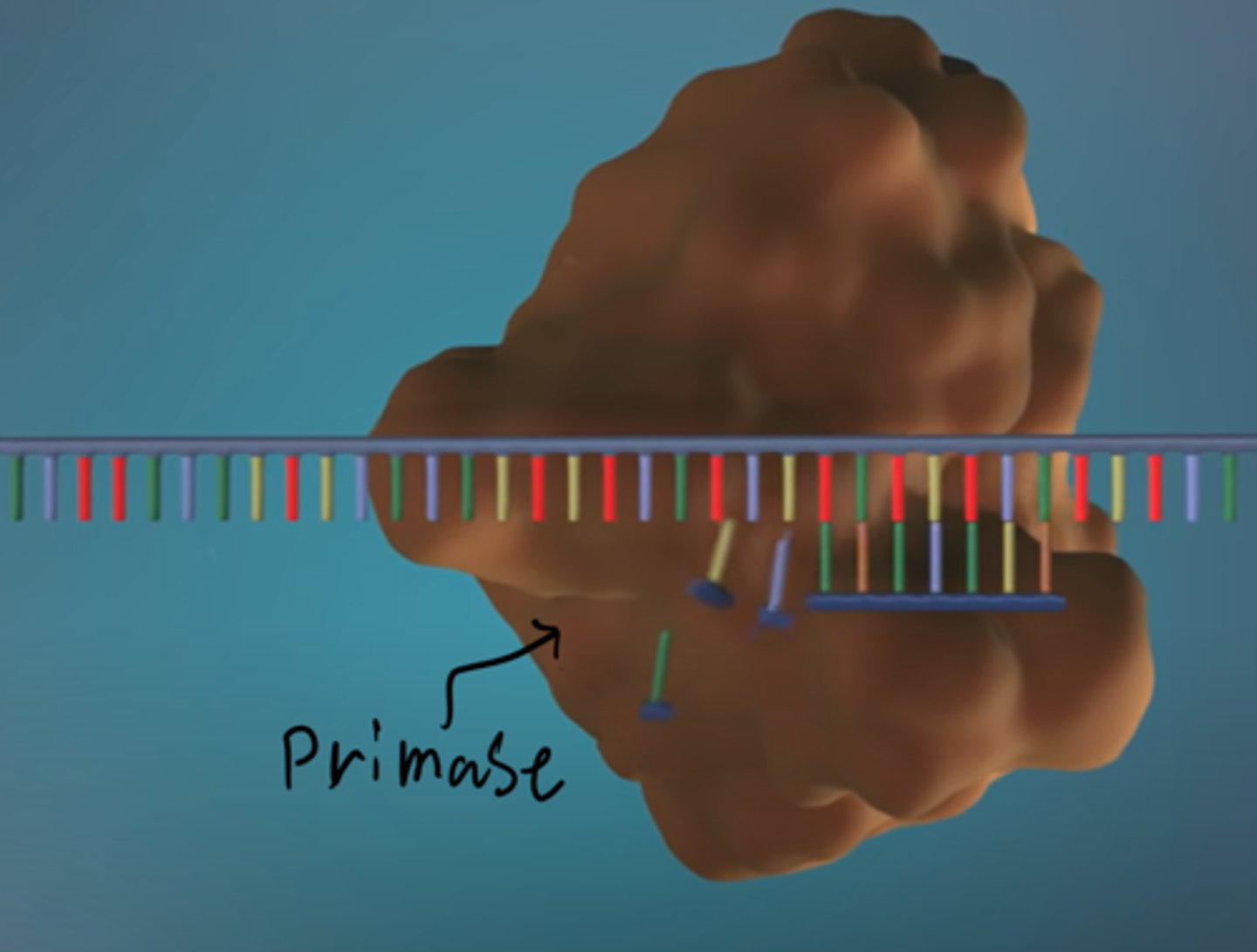
What is the third step of DNA replication?
DNA polymerase binds to the primer, then places DNA bases in the 5' to 3' direction.
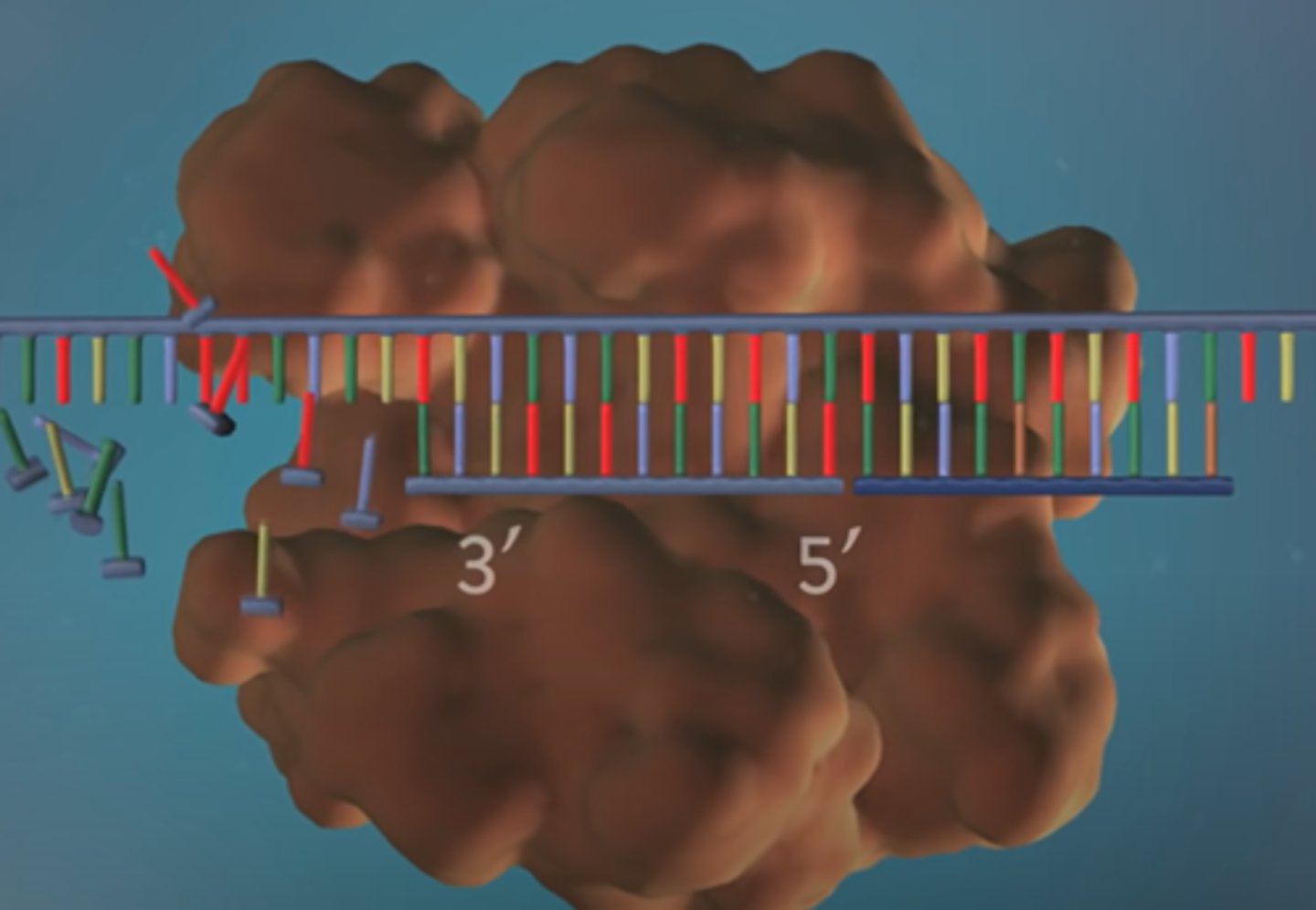
Describe the leading strand in DNA replication
This strand is synthesized continuously because it starts with the 5' end, so DNA polymerase can continuously add bases in the 5' to 3' direction. Only one primer is needed for the leading strand.
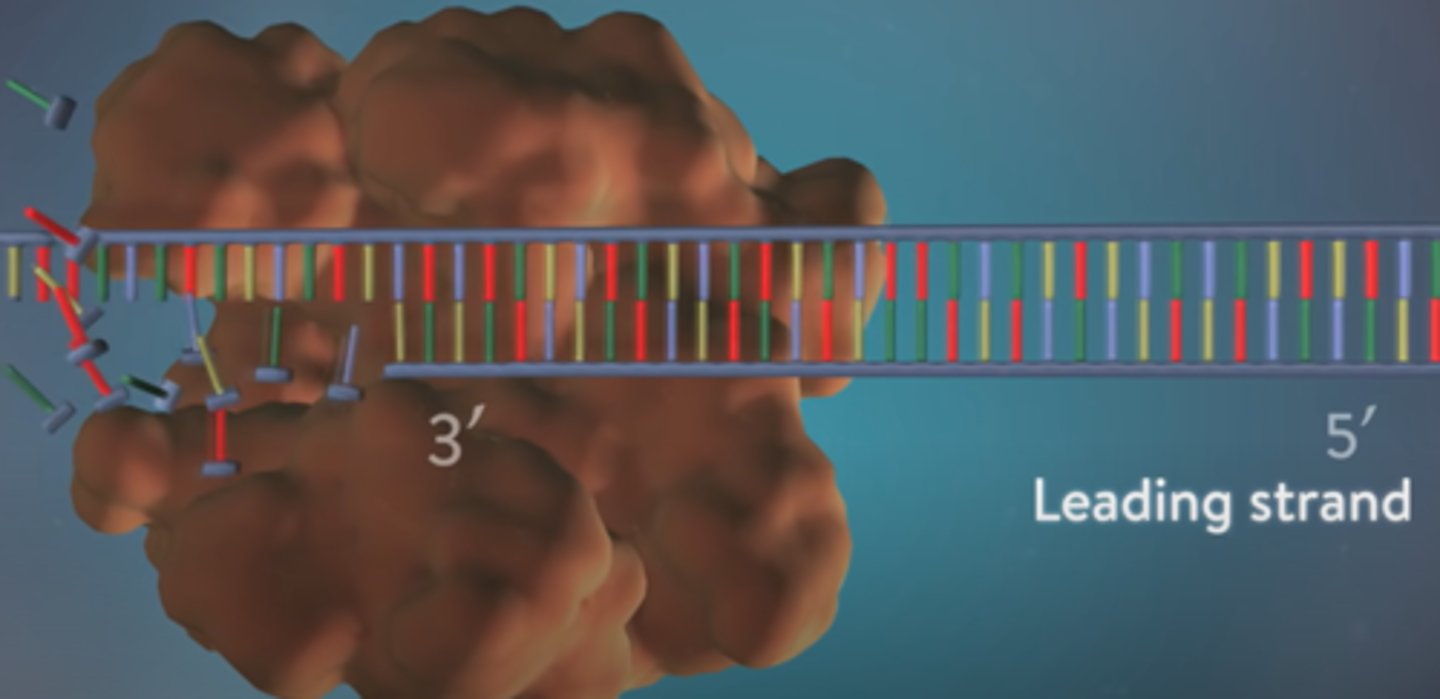
Describe the lagging strand in DNA replication
1. This strand is made in a series of fragments because it starts at the 3' end, so DNA polymerase has to keep going back and starting in a new spot to build in the 5' to 3' direction.
2. A new primer has to be made every time DNA polymerase finishes a strand, so a bunch of primers are made on the lagging strand
3. The fragments are called Okazaki Fragments
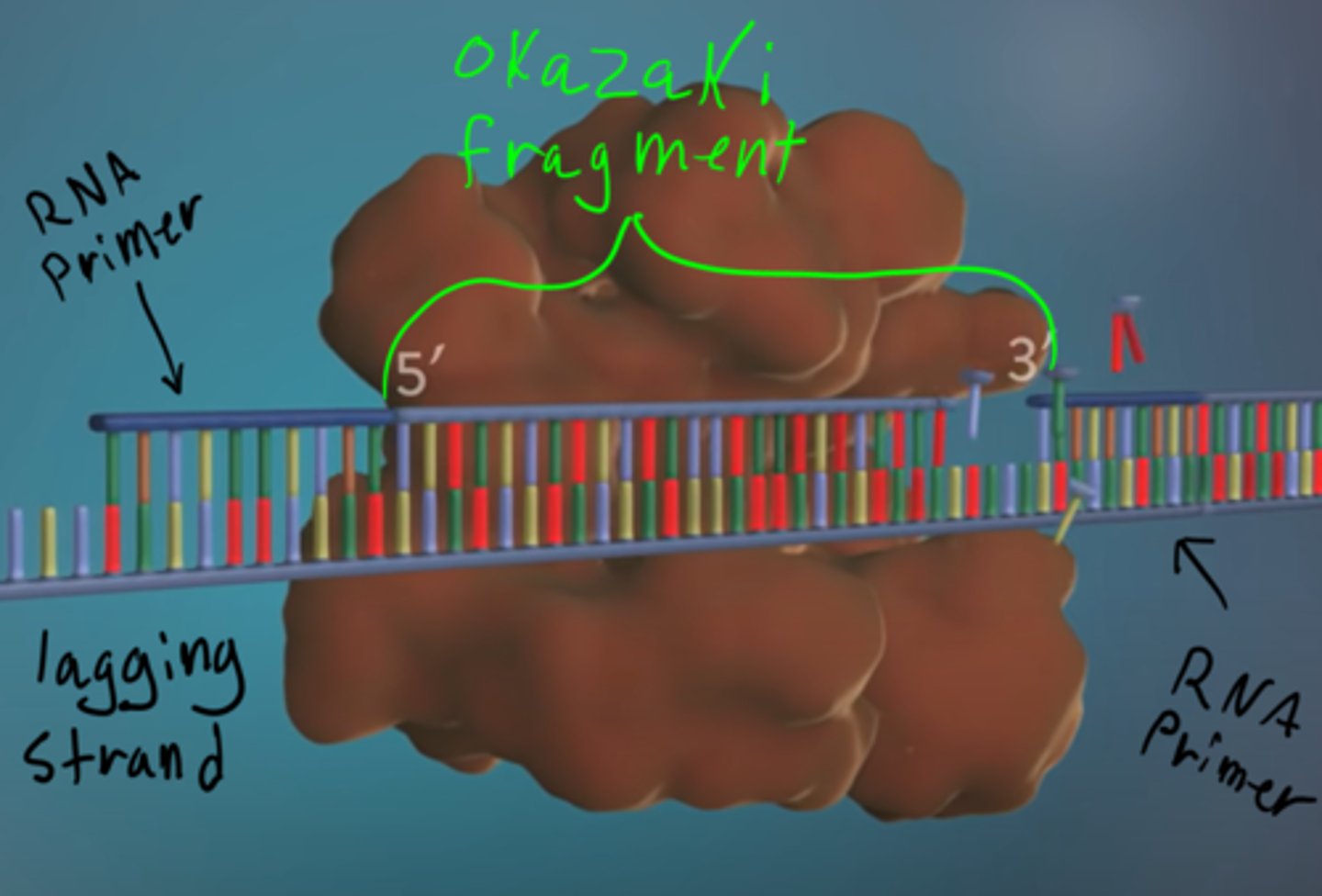
What is the fourth step of DNA replication?
1. Exonuclease removes all the RNA primers from both strands (1 on leading, a ton on lagging)
2. Another DNA polymerase comes back and fills the gaps where the primers where
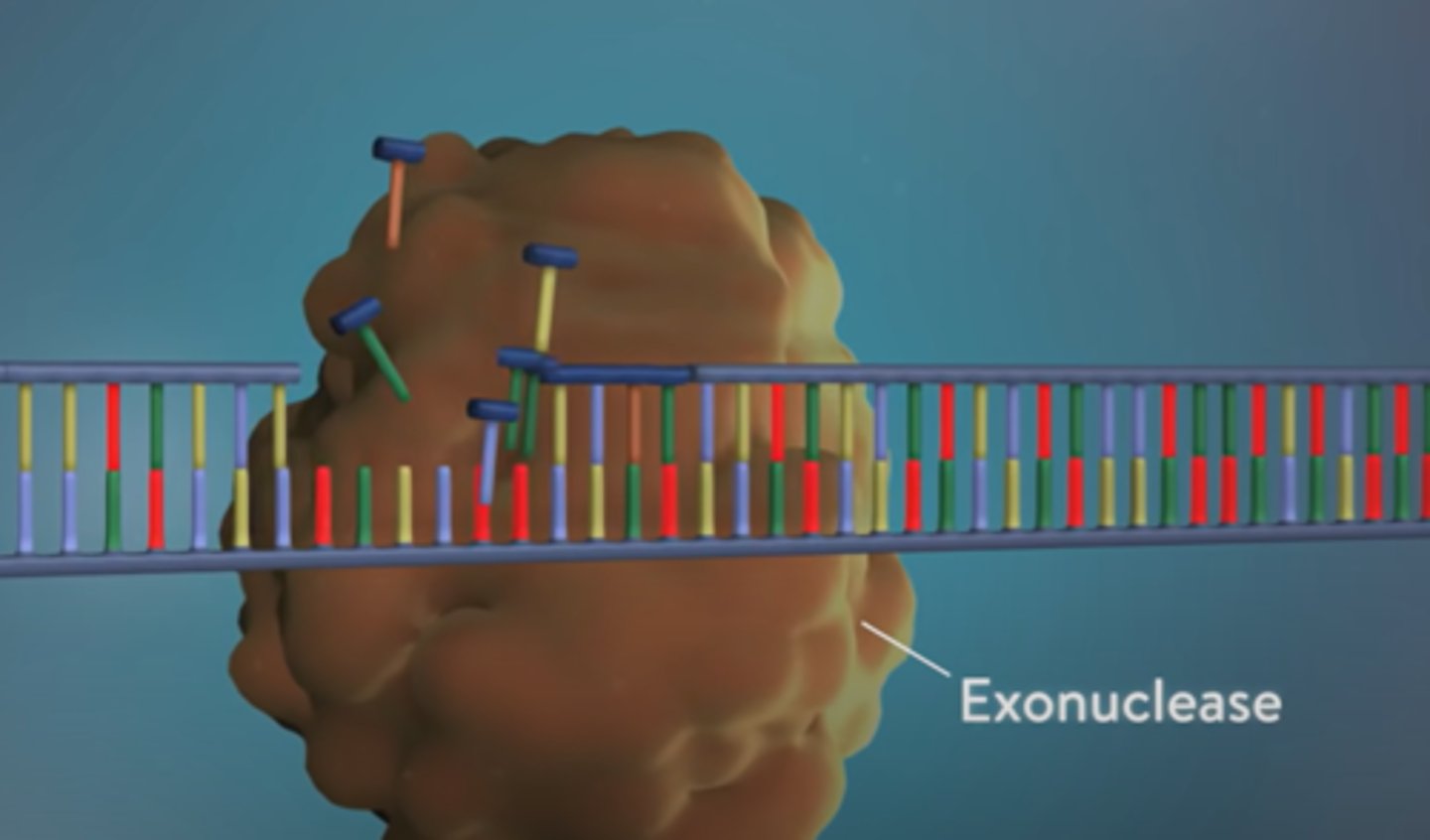
What is the final step of DNA replication?
Ligase joins all fragments together, completing the two continuous DNA strands.
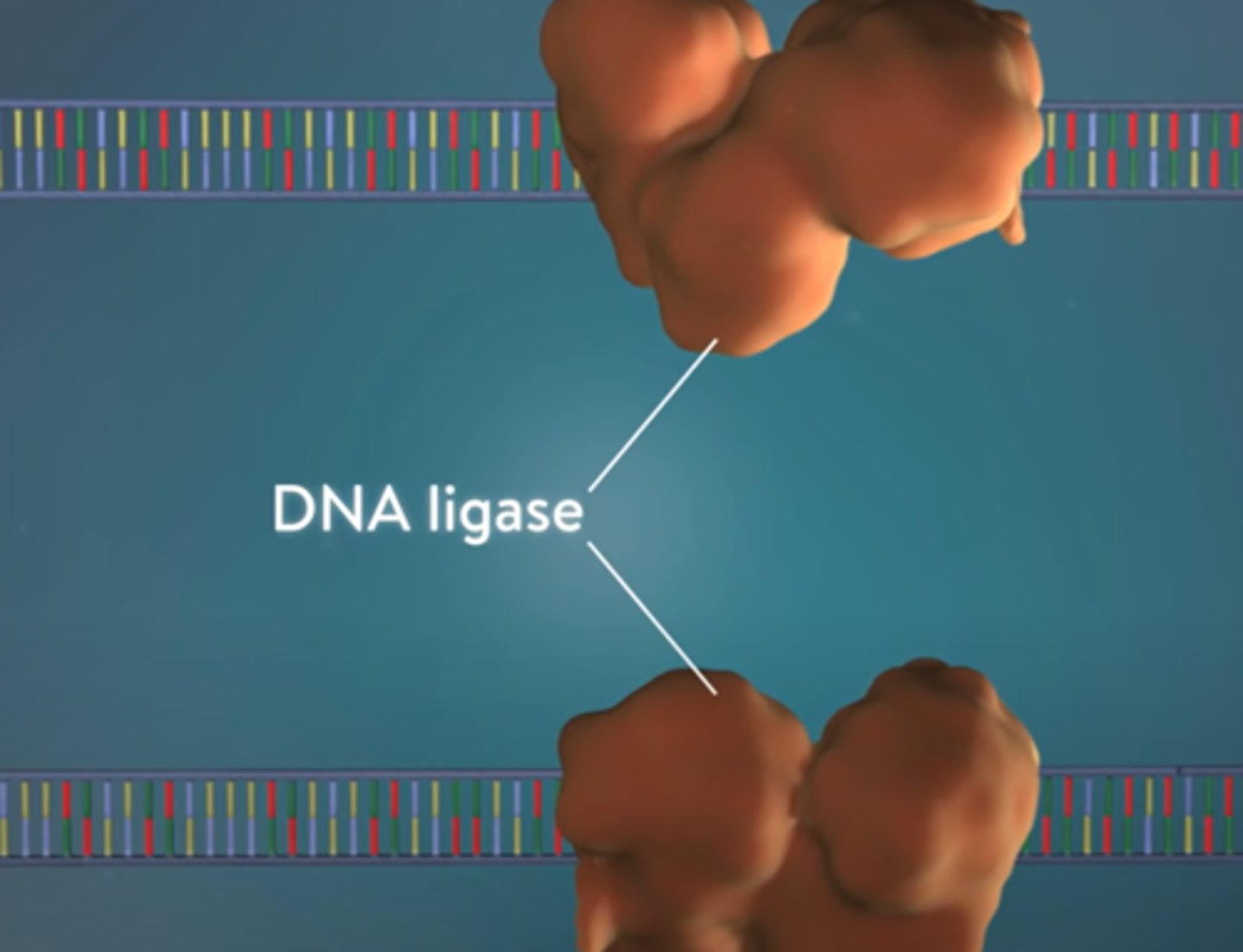
Why is DNA replication describes as semi-conservative?
One half of a new DNA is old, "conserved," and the other half is new.
this ensures that DNA never gets changed

What are the three different types of RNA
1. rRNA: ribosomal RNA - makes up ribosomes
2. tRNA: transfer RNA - transports amino acids to the ribosome
3. mRNA: messenger RNA - sends messages from the nucleus to ribosome
What is the goal of transcription?
To make mRNA from DNA
What is the first step of transcription
Initiation:
When a gene is switched on, RNA polymerase binds to a region called the promoter, which is the spot on DNA that tells RNA polymerase where transcription should start.

What is the second step of transcription?
Elongation:
1. RNA polymerase begins placing RNA bases on the one strand in the 5' to 3' direction, creating a copy of the other DNA strand (with uracil instead of thymine).
2. The strand that the RNA bases are being placed on is called the template strand because that is what is being built from. The other strand is called the coding strand because that is the strand that is being built, or "coded for"
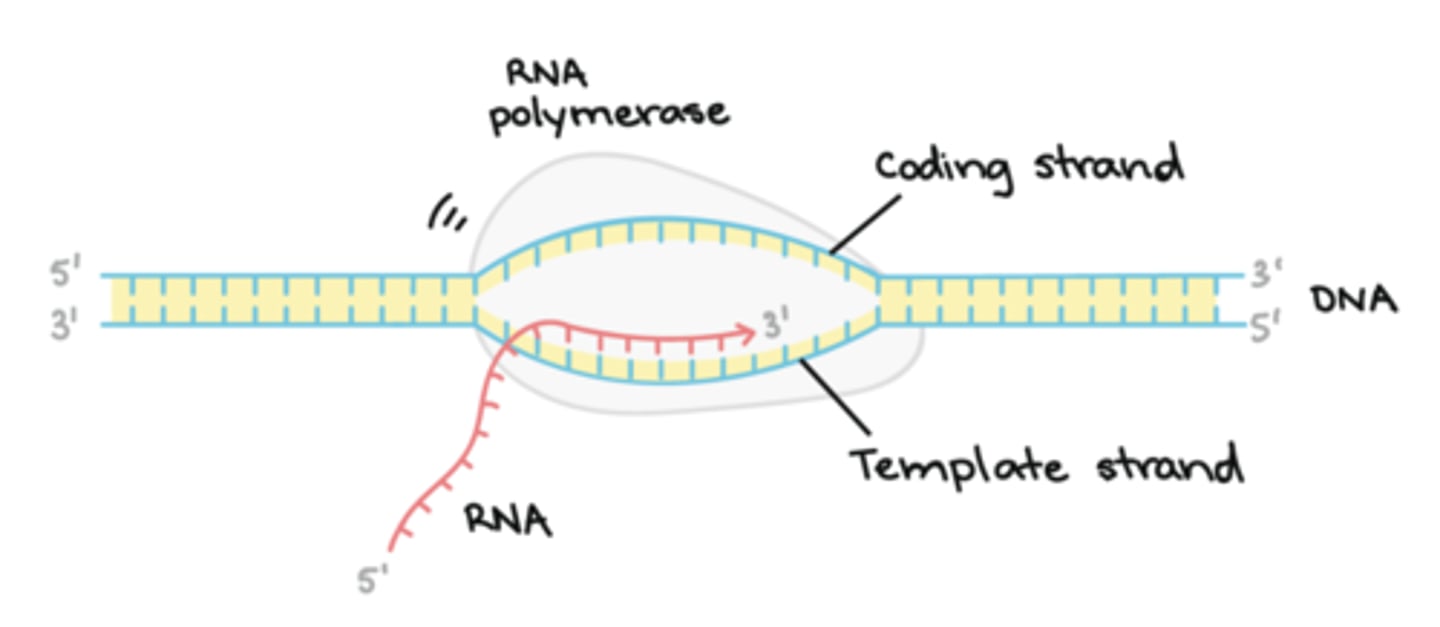
What is the third and final step of transcription?
Termination:
The mRNA will make a hairpin and push RNA polymerase off.
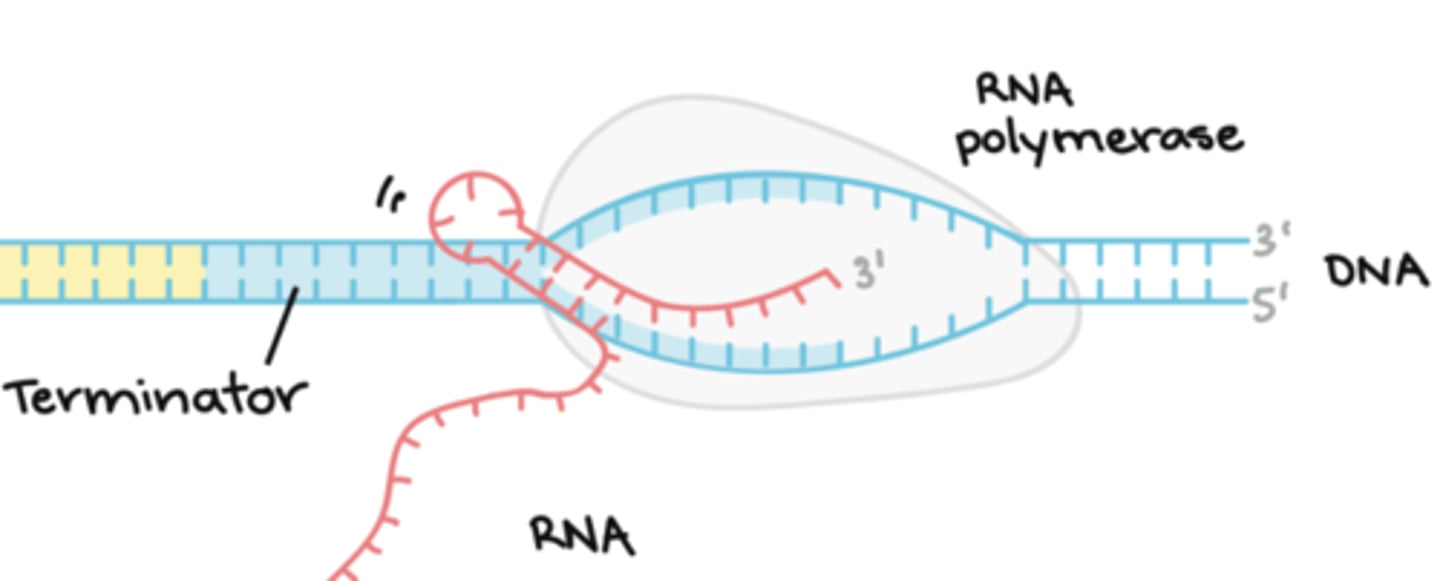
What has to happen before the new mRNA is sent to the ribosome?
Enzyme regulated modifications:
1. A GTP cap is added, doesn't matter why
2. A poly-a tail is added to protect the mRNA from exonuclease enzymes
3. Splicing: the introns (bad parts) are removed from the mRNA and the exons (good parts) stay. Spliceosomes do this.

What is the goal of translation?
to make proteins from mRNA
What is different about prokaryotes and eukaryotes regarding transcription and translation
1. Prokaryotes can do transcription and translation at the same time. This is because they have no nucleus, so the mRNA can feed right into the ribosome
2. In eukaryotes, transcription happens in the nucleus then the mRNA gets sent to the ribosome for translation.
What happens at the very start of translation?
The mRNA arrives at the ribosome, which binds to the mRNA.
The beginning of mRNA will always have the bases AUG because that is the start codon

What is the second step of translation?
1. The mRNA is read three bases at a time in groups called codons, which code for a specific amino acid.
(ex: UGU codes for cysteine)
2. tRNA brings different amino acids depending on the codon it fits with, creating an amino acid sequence (primary structure of protein)
3. These amino acids are joined together through dehydration synthesis (remember from unit 1?)
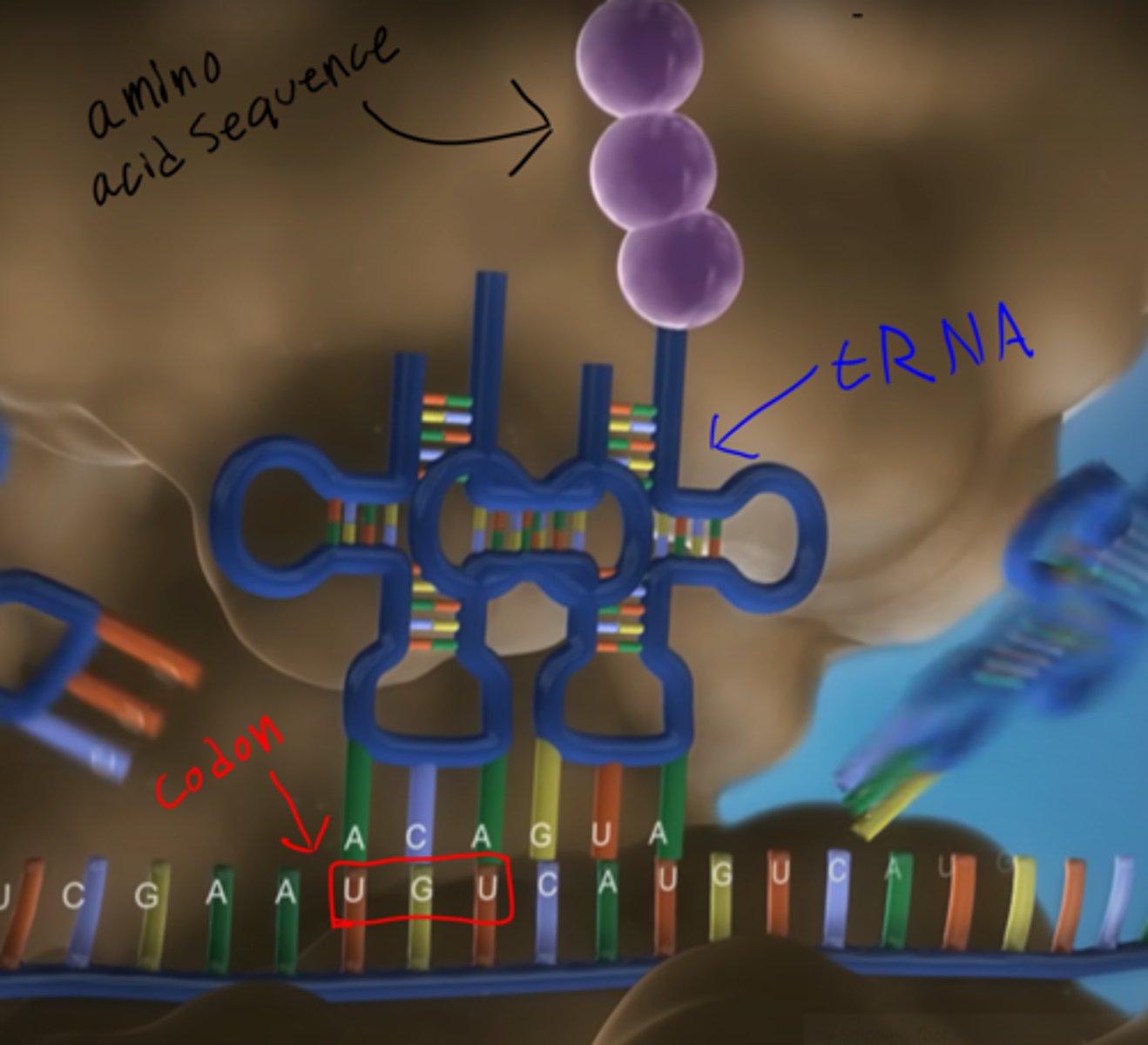
What stops translation?
The codon at the end of the mRNA will always be the "STOP" codon. Which can either be UAA, UAG, or UGA.
This signals that translation is over

What happens after translation?
The amino acid sequence is taken to the rough endoplasmic reticulum where it is folded into a protein.
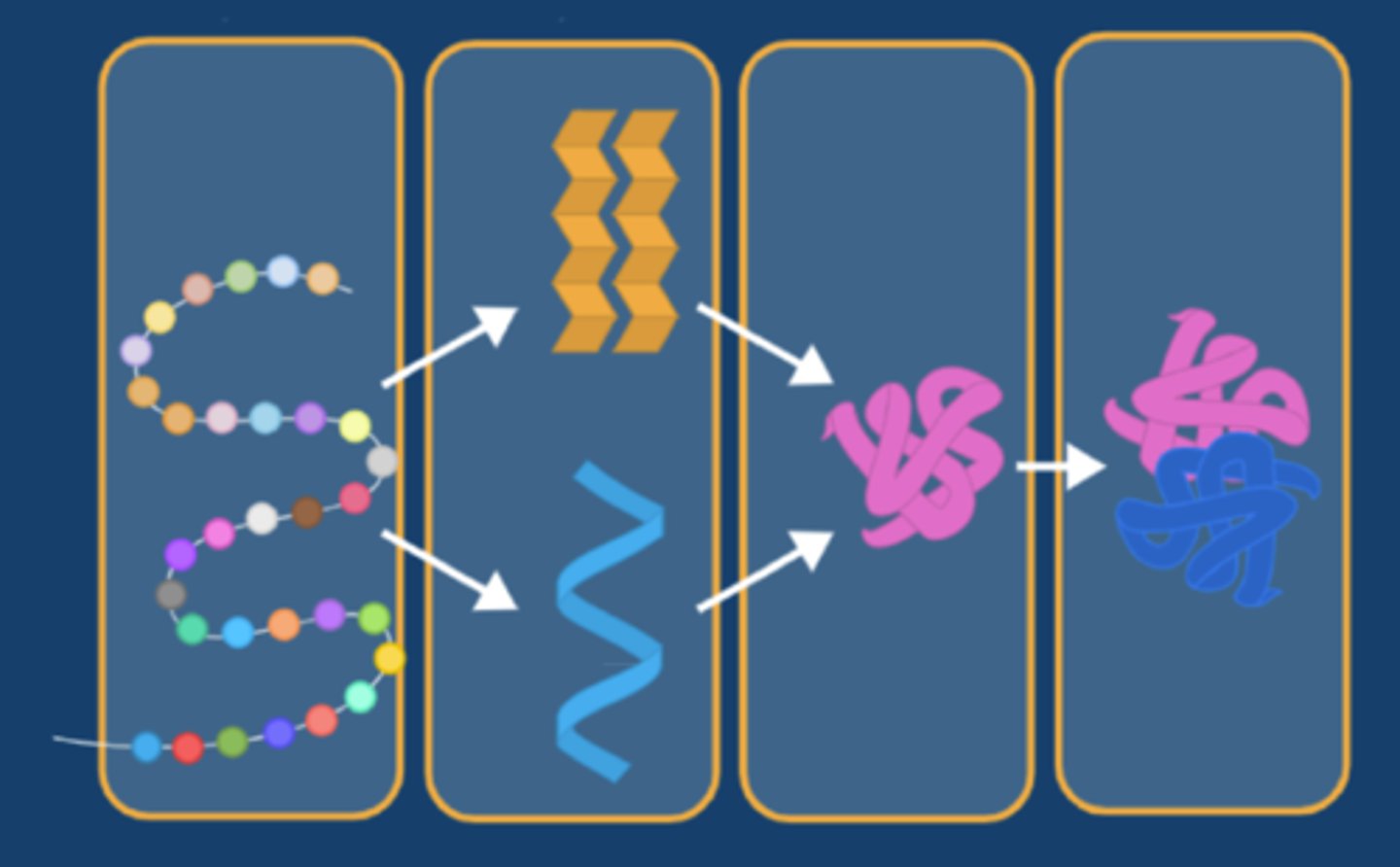
How do transcription and translation have to do with what different parts of the body are doing?
Genes that code for certain functions are only turned on in certain cells in your body.
For example: you have a gene that codes for alcohol dehydrogenase, which detoxifies alcohol. This gene will never be transcribed in your brain cells because you don't detoxify alcohol in your brain.
Likewise, the gene that codes for neurotransmitters will never be transcribed in your liver cells because you don't think with your liver. However these will be transcribed into mRNA in your brain cells because you DO think with your brain.
How do cells know what genes to turn on and off?
1. Transcription factors bind to DNA to regulate gene expression
2. Activators bind to the promoter to turn a gene on and prompt it to start transcription
3. Repressors bind to the silencer keep transcription from happening. Even if there is 50 activators, transcription will not happen if there is 1 repressor

What can cause a gene to be activated?
1. Signals from outside the cell like ligands can signal the cell to create activators
2. signals from inside the cell like damage to DNA can cause activators to be made as well
3. The presence of certain molecules can prompt repressors to fall off the gene
What is a mutation?
A change in DNA sequence
This can happen from mistakes if DNA polymerase messes up or from radiation
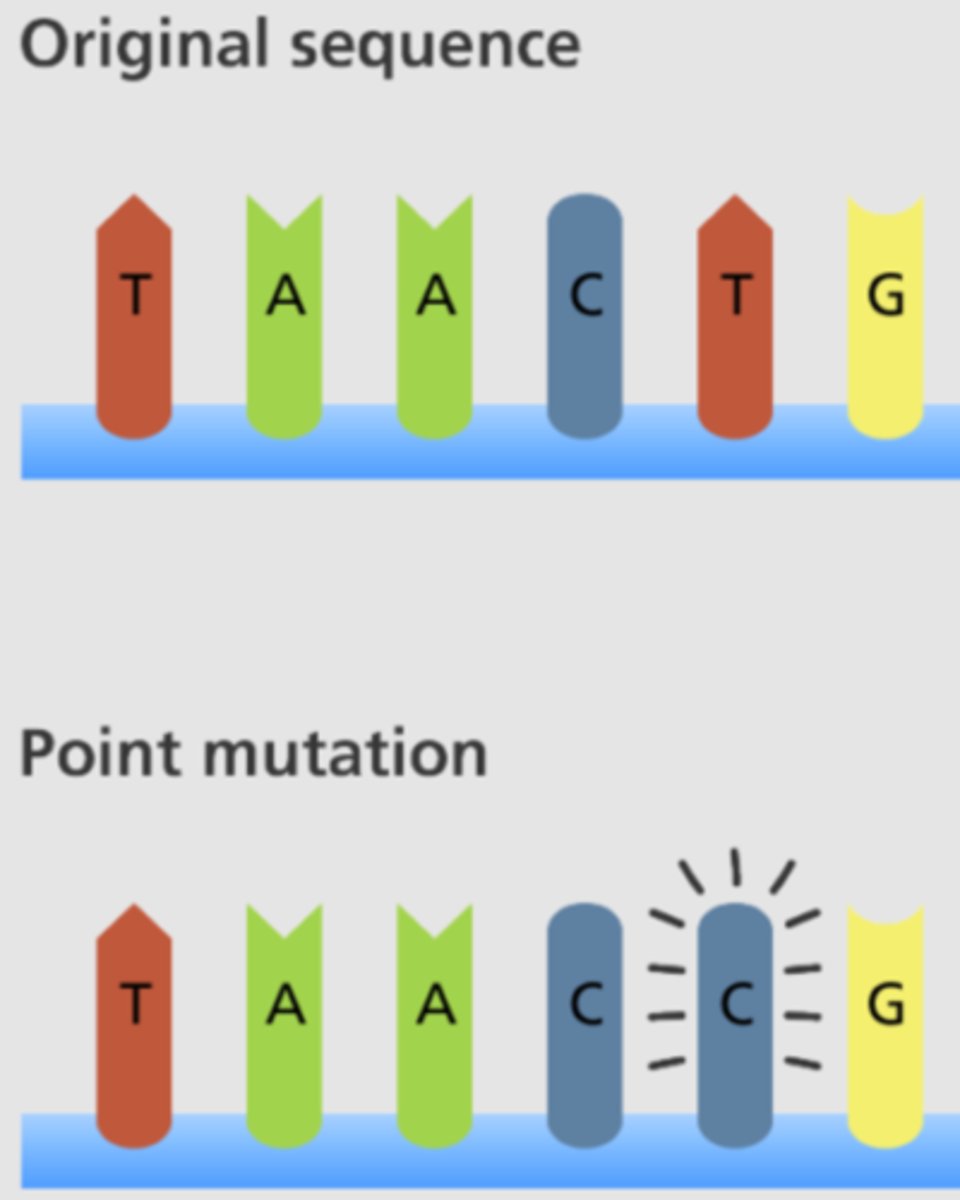
What are the three types of mutations?
1. Substitution: one base s exchanged for another
2. Deletion: One base is missing
3. Insertion: an extra base is added
How can mutations be positive, beneficial, and neutral?
1. A mutation can be positive if it helps a species survive like if it leads to a color that is better camouflage.
2. A mutation can be neutral if it doesn't change the amino acid it codes for.
So if CUU gets changed to CUC it will still code for leucine
3. A mutation can be negative if it leads to a disease or other issue
The environment can change if a mutation is positive or negative. For example a color mutation might be better camouflage in one environment but make the animal stand out in another environment.
Biotechnology is too complicated to explain on flash cards. Just watch the amoeba sisters video about it
https://youtu.be/t3g26p9Mh_k?si=p4jxKPsNSTqK4zQ9
UNIT 7
Natural Selection
What is evolution?
change in allele frequencies in a population over time
What is a population?
One species living together
What are the five microevolutionary forces?
1. Mutation
2. Natural selection
3. Sexual selection
4. Gene flow
5. Genetic drift
What observations did Darwin make about the Galapagos?
1. Overproduction: more babies than the environment can support
2. Limited resources: habitat, food, and mates are not infinit
3. Variation: no two individuals are the same
4. Conclusion: individuals best suited for the environment live longer and have more babies
What is fitness?
ability to survive and reproduce to pass genes on
What is artificial selection?
Selective breeding by humans
Ex: Strawberries have been selectively bred to be really big

What is convergent evolution?
Similar environments lead to similar phenotypes.
Ex: dolphins look like sharks, not closely related though
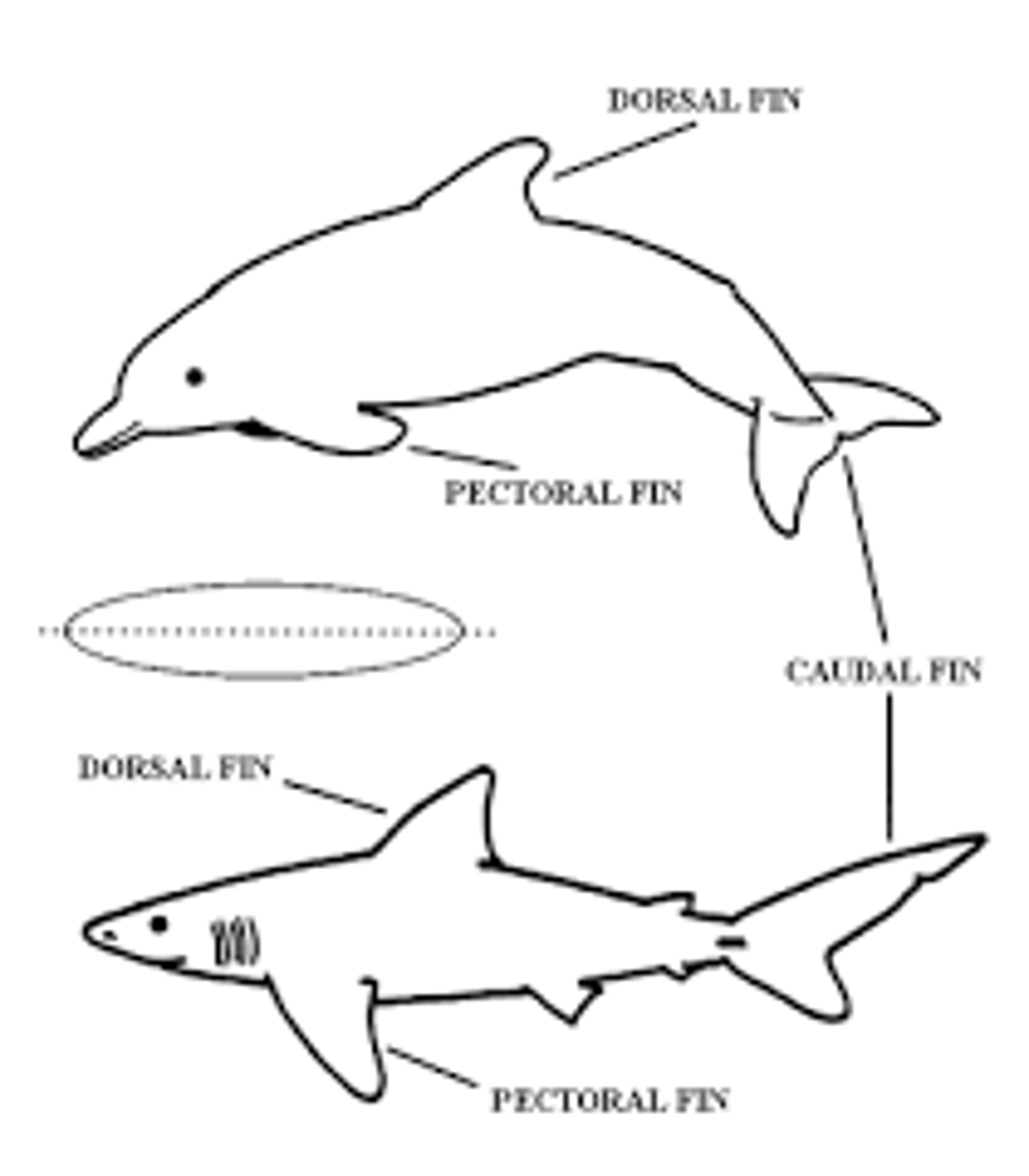
What is sexual selection?
Sexiest animals have the most babies
Ex: in humans, breast size, hip size, head size, and smell can all be indicators on if someone would be better to have kids with
What is genetic drift?
When random events drive evolution.
This is more common in small populations because an individual in a small population dying has a greater effect than an individual dying in a large species
What is the bottleneck effect?
When a large population mostly dies off
this leads to leads diversity, which makes the population less likely to adapt to changes well.
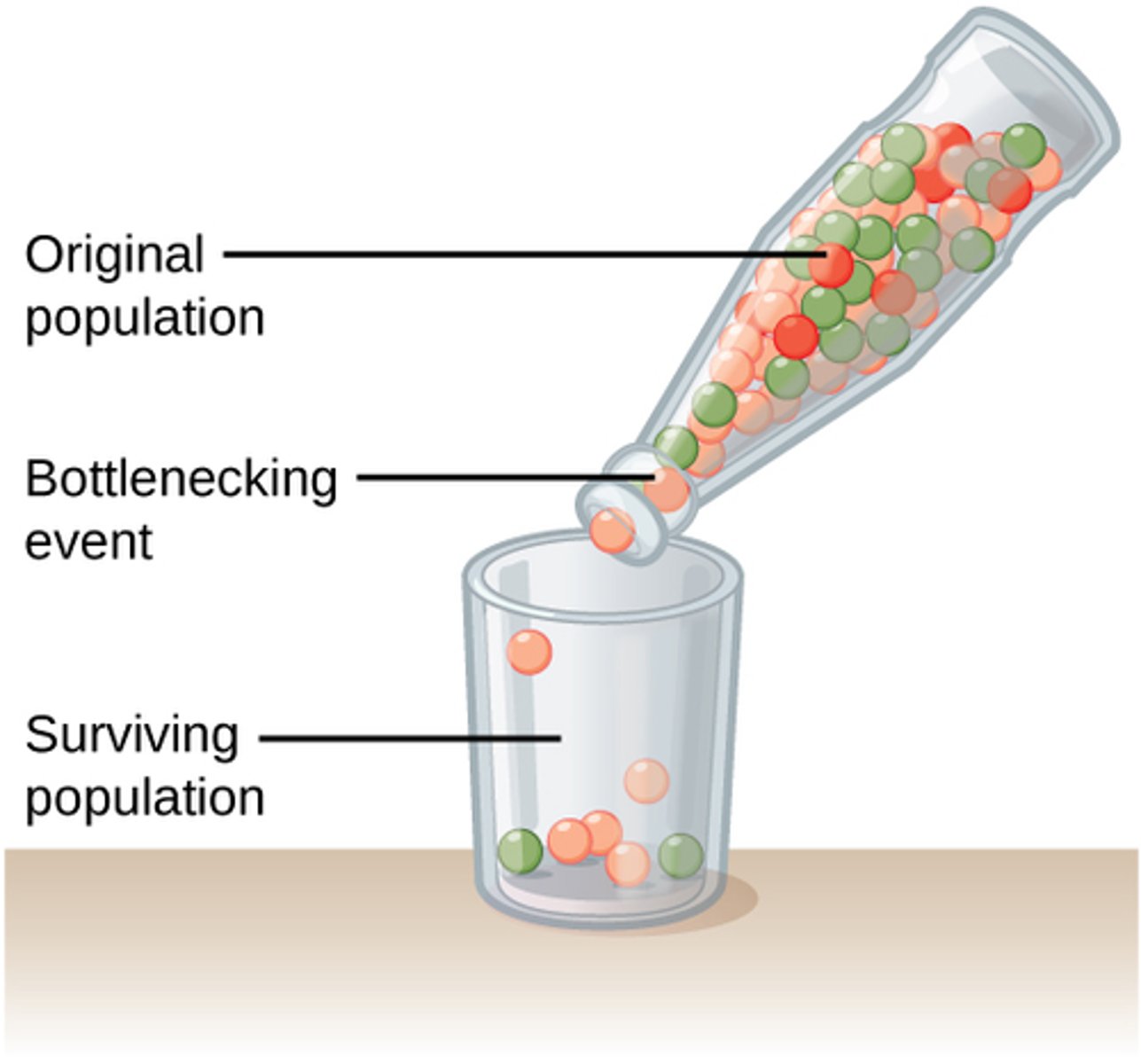
What is the founder effect?
When a small part of a population is found in a new area like an island
This leads to less diversity in the new population
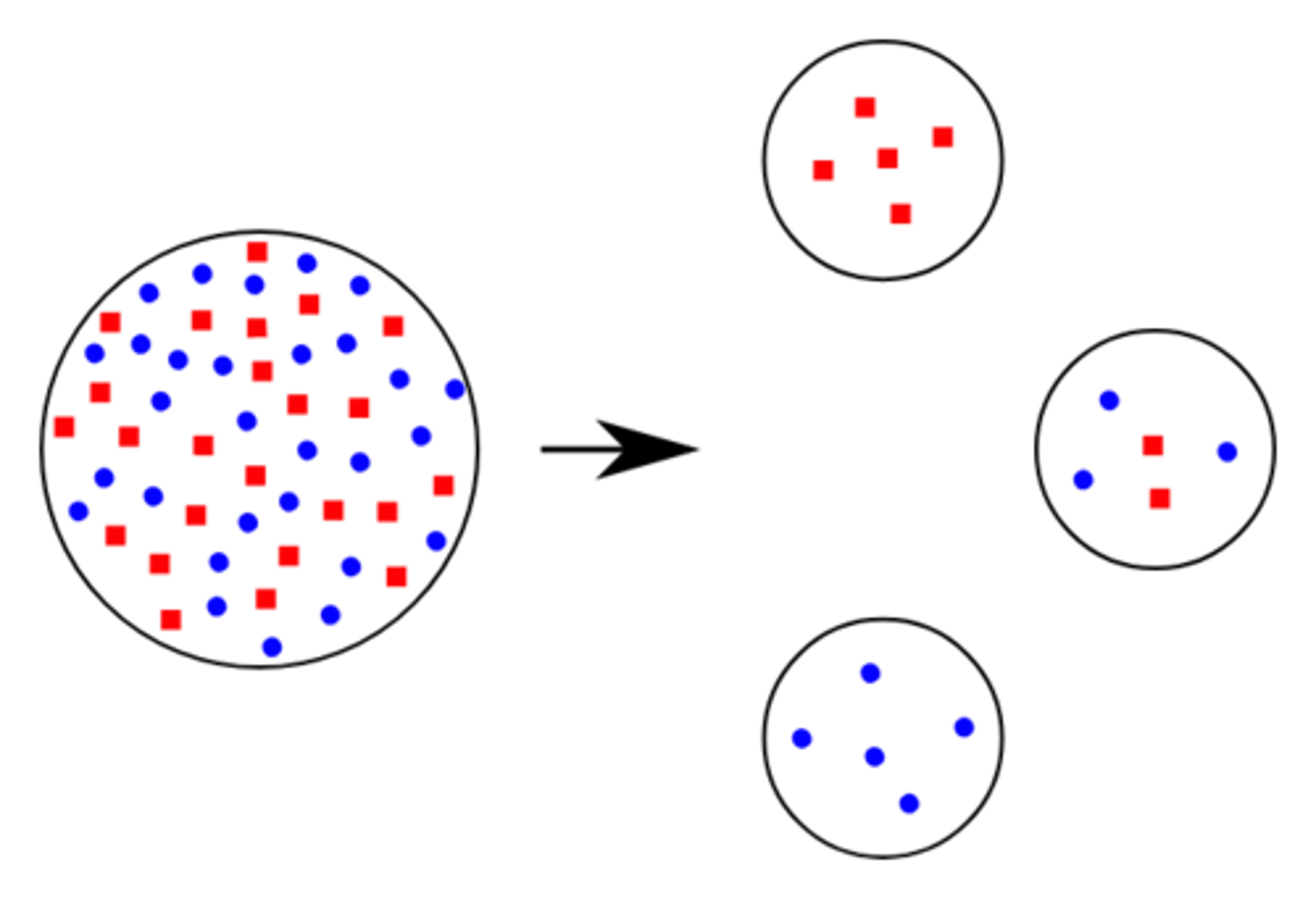
How does migration and gene flow drive evolution
1. If two populations of the same species are separated by mountains, rivers, etc. they will evolve differently
2. If a species from one of these populations migrates to the other population, diversity will increase

What happens with increased variation vs. decreased variation?
1. Decreased variation: the population will be worse at adapting and extinction is more likely
2. Increased variation: better at adapting so extinction is less likely
What are the characteristics of a non evolving population?
1. No mutations
2. No migration
3. No natural selection
4. Random mating (no sexual selection)
5. Large population (no genetic drift)
How is a non evolving population described?
The population is at Hardy Weinberg Equilibrium
What are the Hardy Weinberg equations for predicting allele frequencies in a non evolving population?
p^2 + 2pq + p^2 = 1
p + q = 1
p = A, q = a, p^2 = AA, q^2 = aa, pq = Aa
So, if you are given that the frequency of a recessive trait is .16, sub .16 in for q^2 because that would be aa
What evidence suggests that eukaryotes have common ancestry?
1. They all have genes containing introns
2. They all have linear chromosomes
3. they all have membrane bound organelles
What is phylogeny?
Evolutionary relationships among organisms
How is a phylogenetic tree interpreted?
if you have a more recent common ancestor, you are more related.
An easy example of this is that you are more related to your sister than your cousin

What is a sister group on a phylogenetic tree?
Two species with the most recent common ancestor

What is the out group on a phylogenetic tree?
The most distant relative on the tree
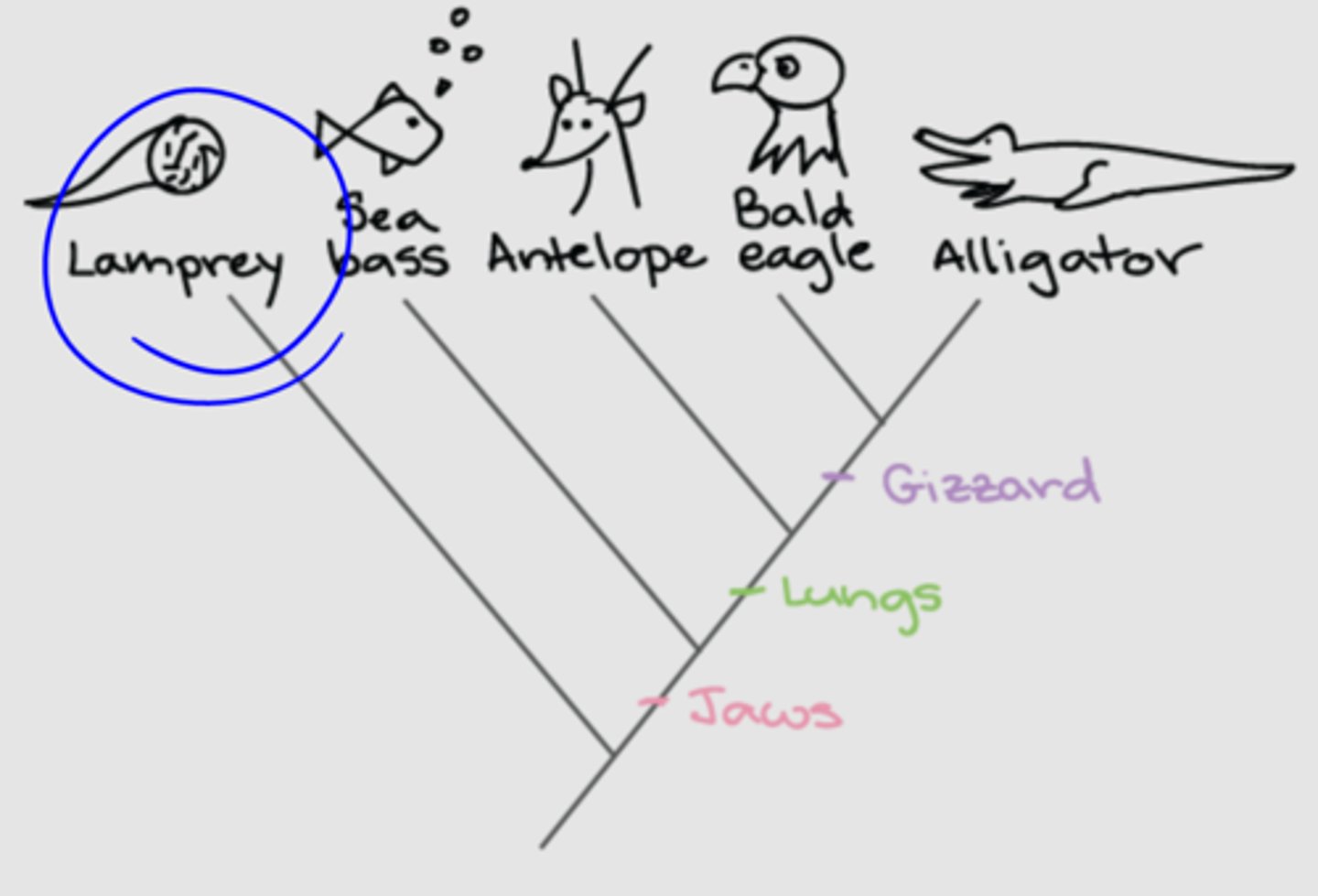
What conditions can indicate that organisms are different species?
1. Reproductive isolation: Can't reproduce together
2. Geographic: won't live together
3. Physiological: different cellular mechanisms
4. Behavioral: don't recognize each other (will not mate)
5. Genetic: chromosome differences
What ultimately determines if organisms are the same species?
If they can breed in nature and produce fertile offspring
appearance doesn't matter!
What are the two ways a species can diverge?
1. Punctuated equilibrium: rapid speciation, usually after mass extinction
2. Gradualism: a species gradually diverges from two groups accumulating differences
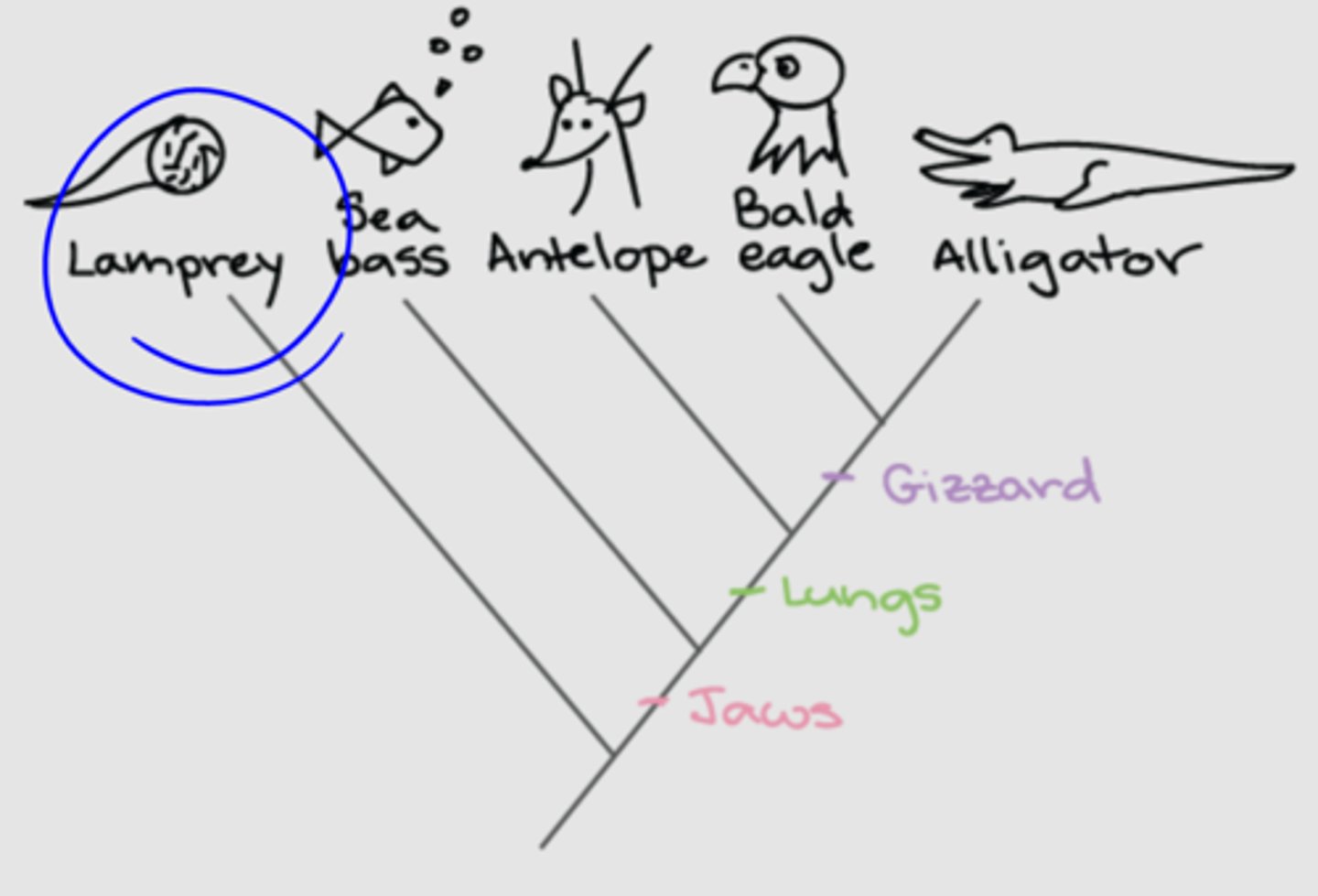
What is divergent evolution?
Two groups from a common ancestor accumulate differences
Ex: dolphins and tigers have a more recent common ancestor than dolphins and sharks. Tigers have just accumulated many differences
What is a mass extinction and why do they happen?
1. Definition: at least half of everything dies in a short period of time
2. Happens because of Environmental changes
What are two theories about the origin of life?
1. Organic material came from a meteor
2. Primitive earth had free energy and no O2, allowing life to form
What evidence is there that life formed on its own?
Humans have been able to make biological molecules such as carbohydrates and DNA by simulating primitive earth. However, no onw has every made a cell.
What is the RNA world hypothesis?
RNA came first
life on earth began with a simple RNA molecule that could copy itself
What are the classifications of organisms? What are humans in each of these classifications?
1. Kingdom: Animalia
2. phylum: chordata
3. class: mammalia
4. Order: primate
5. family: hominidae
6. genus: homo
7. species: sapiens